Buyer Behaviour and Integrated Marketing Communication
VerifiedAdded on 2023/06/10
|25
|4834
|243
AI Summary
This article discusses the analysis of buyer's behavior, target market, CDP model, IMC strategy, and creative strategy for Mini One 5-door car. The target market is young women aged between 18 to 35 years with a monthly income of $7000 to $10000. The CDP model includes problem recognition, searching information, assessment of alternatives, purchase, and post-purchase. The IMC strategy includes context analysis, communication goals, positioning strategy, and creative strategy. The creative strategy includes both emotional and rational approaches for demonstrating the product.
Contribute Materials
Your contribution can guide someone’s learning journey. Share your
documents today.
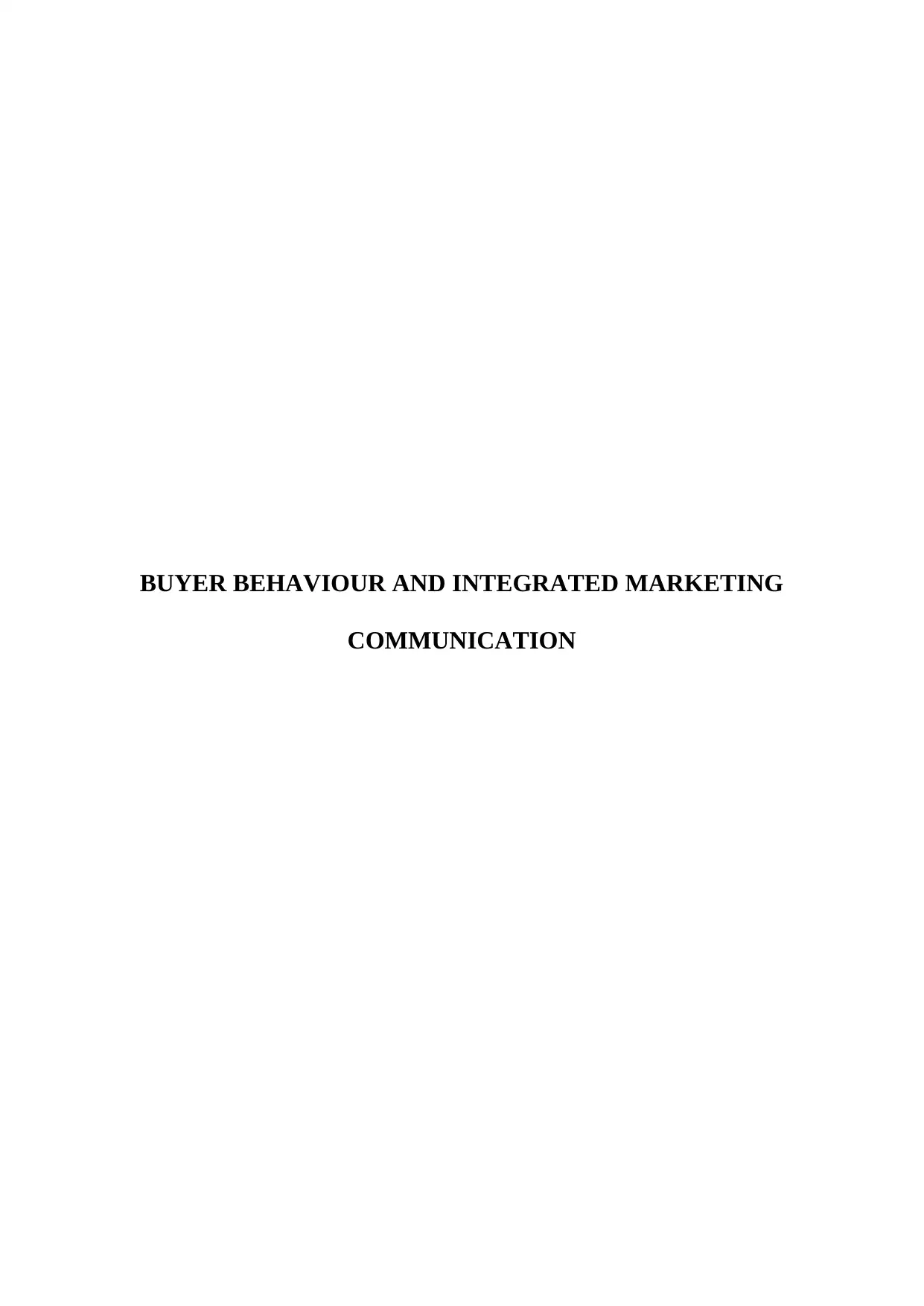
BUYER BEHAVIOUR AND INTEGRATED MARKETING
COMMUNICATION
COMMUNICATION
Secure Best Marks with AI Grader
Need help grading? Try our AI Grader for instant feedback on your assignments.

Table of Contents
1.0 Introduction..........................................................................................................................3
1.1 Background of the company.............................................................................................3
1.2 Background of the product...............................................................................................3
1.3 Market issues....................................................................................................................3
2.0 Analysis of buyer’s behavior................................................................................................4
2.1 Target market....................................................................................................................4
2.2 Target market profile........................................................................................................4
2.3 Degree of problem-solving (EPS): Depending factors.....................................................5
2.4 CDP Model.......................................................................................................................5
2.5 Different influences..........................................................................................................8
3. IMC strategy...........................................................................................................................8
3.1 Context analysis................................................................................................................8
3.2 Communication goals.....................................................................................................12
3.3 Positioning strategy........................................................................................................13
3.4 Creative strategy.............................................................................................................14
3.5 Marcom tools..................................................................................................................15
3.6 Media scheduling............................................................................................................18
3.7 Control and Assessment.................................................................................................18
4. Conclusion............................................................................................................................20
Reference list............................................................................................................................21
1.0 Introduction..........................................................................................................................3
1.1 Background of the company.............................................................................................3
1.2 Background of the product...............................................................................................3
1.3 Market issues....................................................................................................................3
2.0 Analysis of buyer’s behavior................................................................................................4
2.1 Target market....................................................................................................................4
2.2 Target market profile........................................................................................................4
2.3 Degree of problem-solving (EPS): Depending factors.....................................................5
2.4 CDP Model.......................................................................................................................5
2.5 Different influences..........................................................................................................8
3. IMC strategy...........................................................................................................................8
3.1 Context analysis................................................................................................................8
3.2 Communication goals.....................................................................................................12
3.3 Positioning strategy........................................................................................................13
3.4 Creative strategy.............................................................................................................14
3.5 Marcom tools..................................................................................................................15
3.6 Media scheduling............................................................................................................18
3.7 Control and Assessment.................................................................................................18
4. Conclusion............................................................................................................................20
Reference list............................................................................................................................21
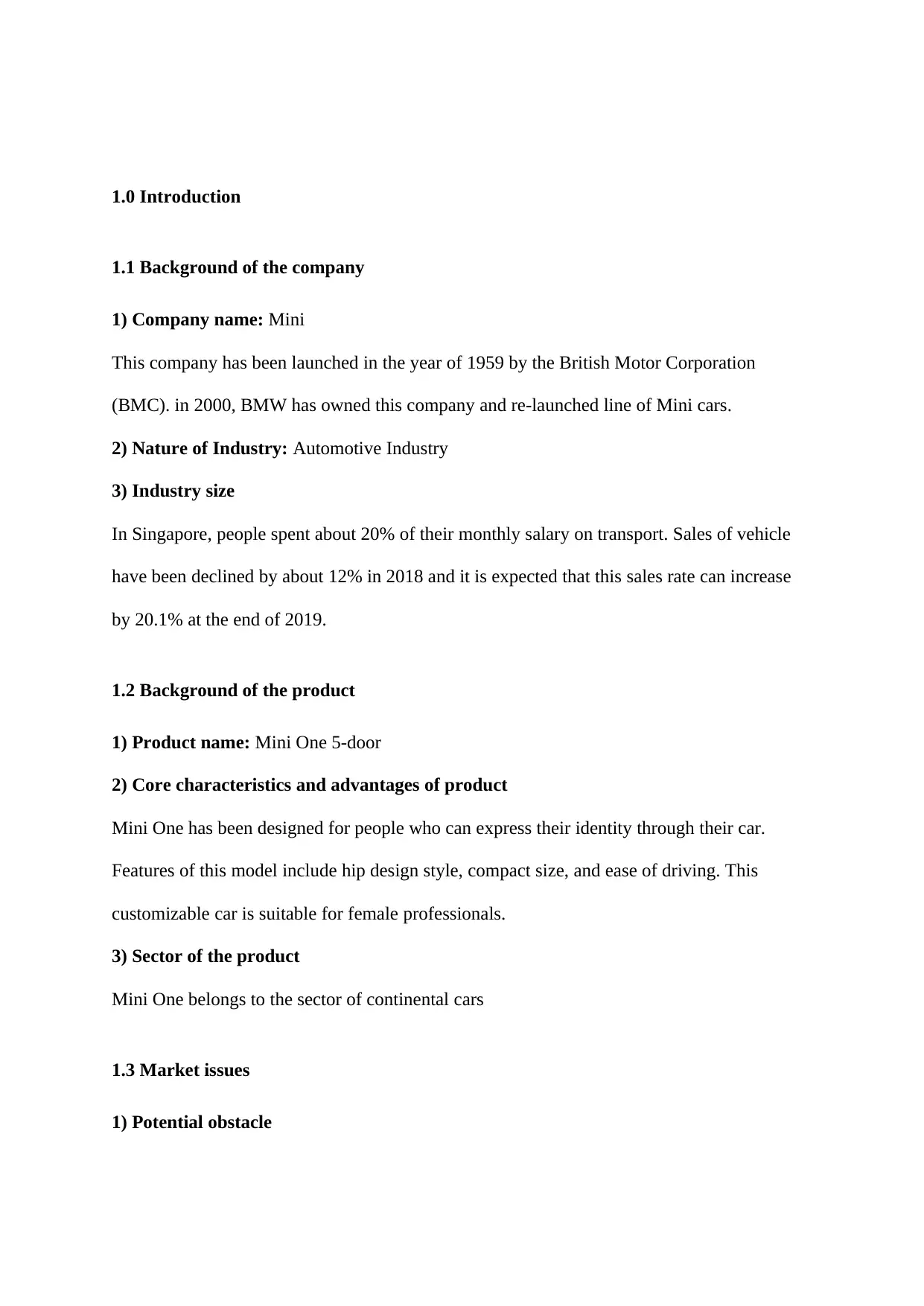
1.0 Introduction
1.1 Background of the company
1) Company name: Mini
This company has been launched in the year of 1959 by the British Motor Corporation
(BMC). in 2000, BMW has owned this company and re-launched line of Mini cars.
2) Nature of Industry: Automotive Industry
3) Industry size
In Singapore, people spent about 20% of their monthly salary on transport. Sales of vehicle
have been declined by about 12% in 2018 and it is expected that this sales rate can increase
by 20.1% at the end of 2019.
1.2 Background of the product
1) Product name: Mini One 5-door
2) Core characteristics and advantages of product
Mini One has been designed for people who can express their identity through their car.
Features of this model include hip design style, compact size, and ease of driving. This
customizable car is suitable for female professionals.
3) Sector of the product
Mini One belongs to the sector of continental cars
1.3 Market issues
1) Potential obstacle
1.1 Background of the company
1) Company name: Mini
This company has been launched in the year of 1959 by the British Motor Corporation
(BMC). in 2000, BMW has owned this company and re-launched line of Mini cars.
2) Nature of Industry: Automotive Industry
3) Industry size
In Singapore, people spent about 20% of their monthly salary on transport. Sales of vehicle
have been declined by about 12% in 2018 and it is expected that this sales rate can increase
by 20.1% at the end of 2019.
1.2 Background of the product
1) Product name: Mini One 5-door
2) Core characteristics and advantages of product
Mini One has been designed for people who can express their identity through their car.
Features of this model include hip design style, compact size, and ease of driving. This
customizable car is suitable for female professionals.
3) Sector of the product
Mini One belongs to the sector of continental cars
1.3 Market issues
1) Potential obstacle
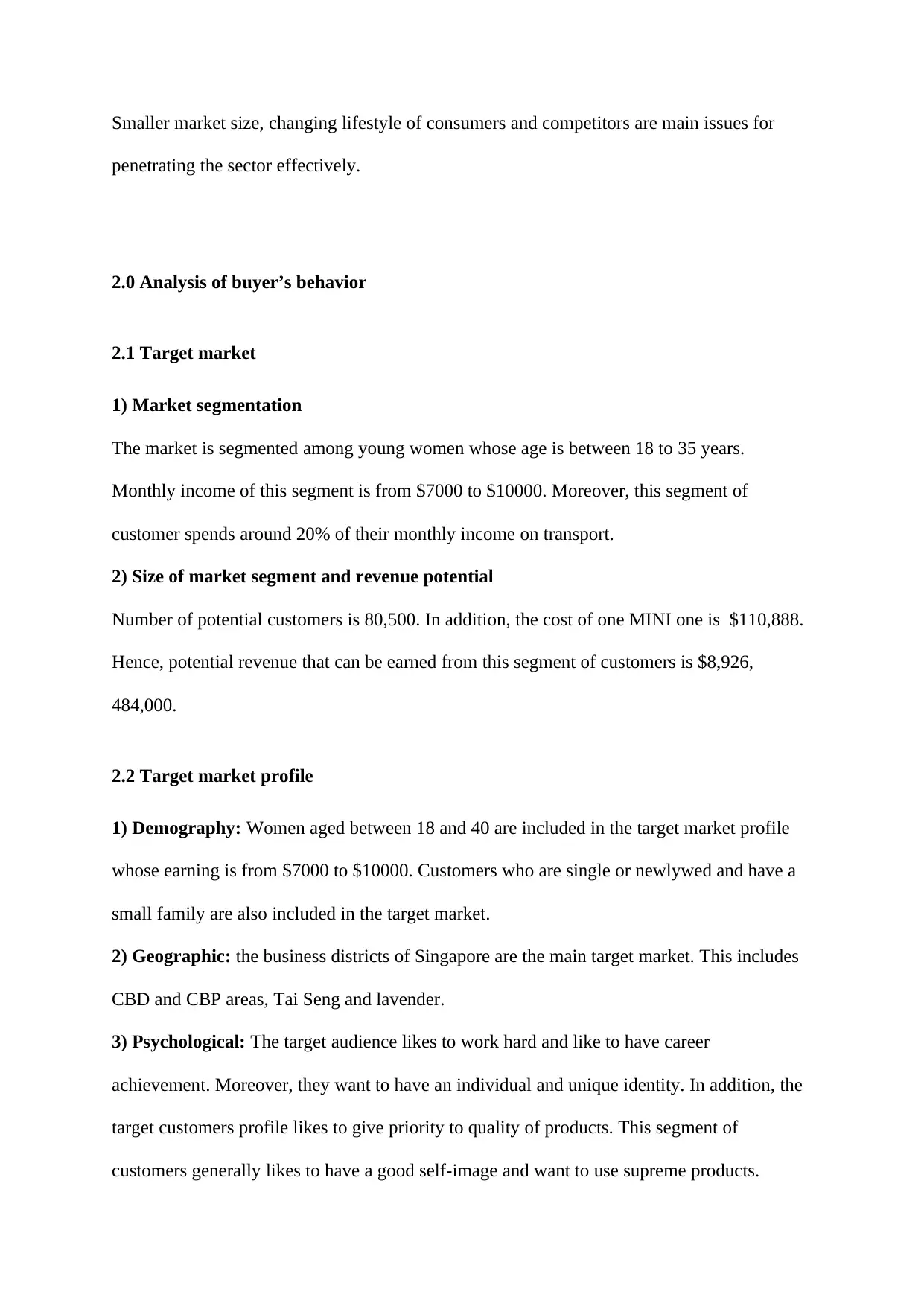
Smaller market size, changing lifestyle of consumers and competitors are main issues for
penetrating the sector effectively.
2.0 Analysis of buyer’s behavior
2.1 Target market
1) Market segmentation
The market is segmented among young women whose age is between 18 to 35 years.
Monthly income of this segment is from $7000 to $10000. Moreover, this segment of
customer spends around 20% of their monthly income on transport.
2) Size of market segment and revenue potential
Number of potential customers is 80,500. In addition, the cost of one MINI one is $110,888.
Hence, potential revenue that can be earned from this segment of customers is $8,926,
484,000.
2.2 Target market profile
1) Demography: Women aged between 18 and 40 are included in the target market profile
whose earning is from $7000 to $10000. Customers who are single or newlywed and have a
small family are also included in the target market.
2) Geographic: the business districts of Singapore are the main target market. This includes
CBD and CBP areas, Tai Seng and lavender.
3) Psychological: The target audience likes to work hard and like to have career
achievement. Moreover, they want to have an individual and unique identity. In addition, the
target customers profile likes to give priority to quality of products. This segment of
customers generally likes to have a good self-image and want to use supreme products.
penetrating the sector effectively.
2.0 Analysis of buyer’s behavior
2.1 Target market
1) Market segmentation
The market is segmented among young women whose age is between 18 to 35 years.
Monthly income of this segment is from $7000 to $10000. Moreover, this segment of
customer spends around 20% of their monthly income on transport.
2) Size of market segment and revenue potential
Number of potential customers is 80,500. In addition, the cost of one MINI one is $110,888.
Hence, potential revenue that can be earned from this segment of customers is $8,926,
484,000.
2.2 Target market profile
1) Demography: Women aged between 18 and 40 are included in the target market profile
whose earning is from $7000 to $10000. Customers who are single or newlywed and have a
small family are also included in the target market.
2) Geographic: the business districts of Singapore are the main target market. This includes
CBD and CBP areas, Tai Seng and lavender.
3) Psychological: The target audience likes to work hard and like to have career
achievement. Moreover, they want to have an individual and unique identity. In addition, the
target customers profile likes to give priority to quality of products. This segment of
customers generally likes to have a good self-image and want to use supreme products.
Secure Best Marks with AI Grader
Need help grading? Try our AI Grader for instant feedback on your assignments.
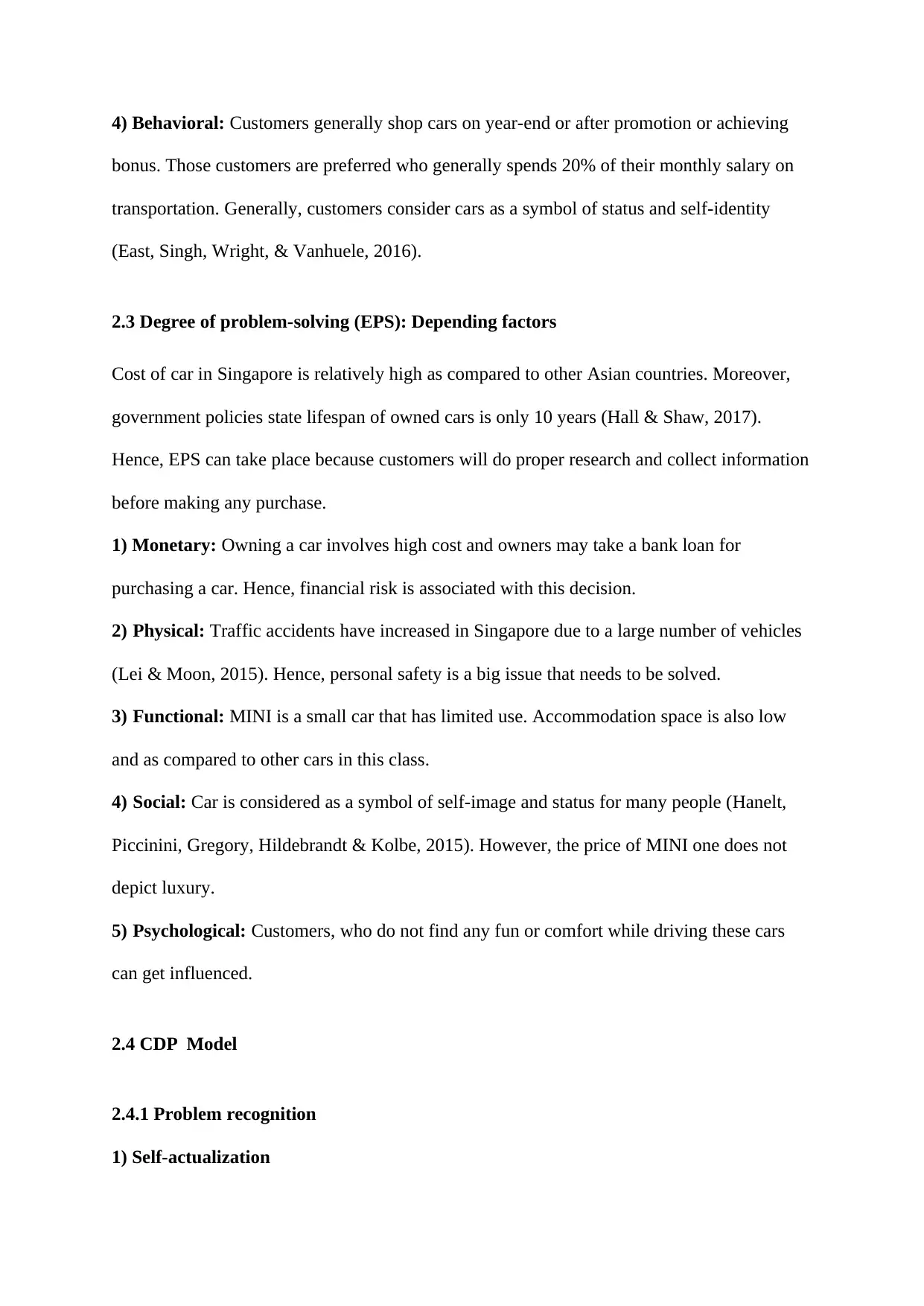
4) Behavioral: Customers generally shop cars on year-end or after promotion or achieving
bonus. Those customers are preferred who generally spends 20% of their monthly salary on
transportation. Generally, customers consider cars as a symbol of status and self-identity
(East, Singh, Wright, & Vanhuele, 2016).
2.3 Degree of problem-solving (EPS): Depending factors
Cost of car in Singapore is relatively high as compared to other Asian countries. Moreover,
government policies state lifespan of owned cars is only 10 years (Hall & Shaw, 2017).
Hence, EPS can take place because customers will do proper research and collect information
before making any purchase.
1) Monetary: Owning a car involves high cost and owners may take a bank loan for
purchasing a car. Hence, financial risk is associated with this decision.
2) Physical: Traffic accidents have increased in Singapore due to a large number of vehicles
(Lei & Moon, 2015). Hence, personal safety is a big issue that needs to be solved.
3) Functional: MINI is a small car that has limited use. Accommodation space is also low
and as compared to other cars in this class.
4) Social: Car is considered as a symbol of self-image and status for many people (Hanelt,
Piccinini, Gregory, Hildebrandt & Kolbe, 2015). However, the price of MINI one does not
depict luxury.
5) Psychological: Customers, who do not find any fun or comfort while driving these cars
can get influenced.
2.4 CDP Model
2.4.1 Problem recognition
1) Self-actualization
bonus. Those customers are preferred who generally spends 20% of their monthly salary on
transportation. Generally, customers consider cars as a symbol of status and self-identity
(East, Singh, Wright, & Vanhuele, 2016).
2.3 Degree of problem-solving (EPS): Depending factors
Cost of car in Singapore is relatively high as compared to other Asian countries. Moreover,
government policies state lifespan of owned cars is only 10 years (Hall & Shaw, 2017).
Hence, EPS can take place because customers will do proper research and collect information
before making any purchase.
1) Monetary: Owning a car involves high cost and owners may take a bank loan for
purchasing a car. Hence, financial risk is associated with this decision.
2) Physical: Traffic accidents have increased in Singapore due to a large number of vehicles
(Lei & Moon, 2015). Hence, personal safety is a big issue that needs to be solved.
3) Functional: MINI is a small car that has limited use. Accommodation space is also low
and as compared to other cars in this class.
4) Social: Car is considered as a symbol of self-image and status for many people (Hanelt,
Piccinini, Gregory, Hildebrandt & Kolbe, 2015). However, the price of MINI one does not
depict luxury.
5) Psychological: Customers, who do not find any fun or comfort while driving these cars
can get influenced.
2.4 CDP Model
2.4.1 Problem recognition
1) Self-actualization
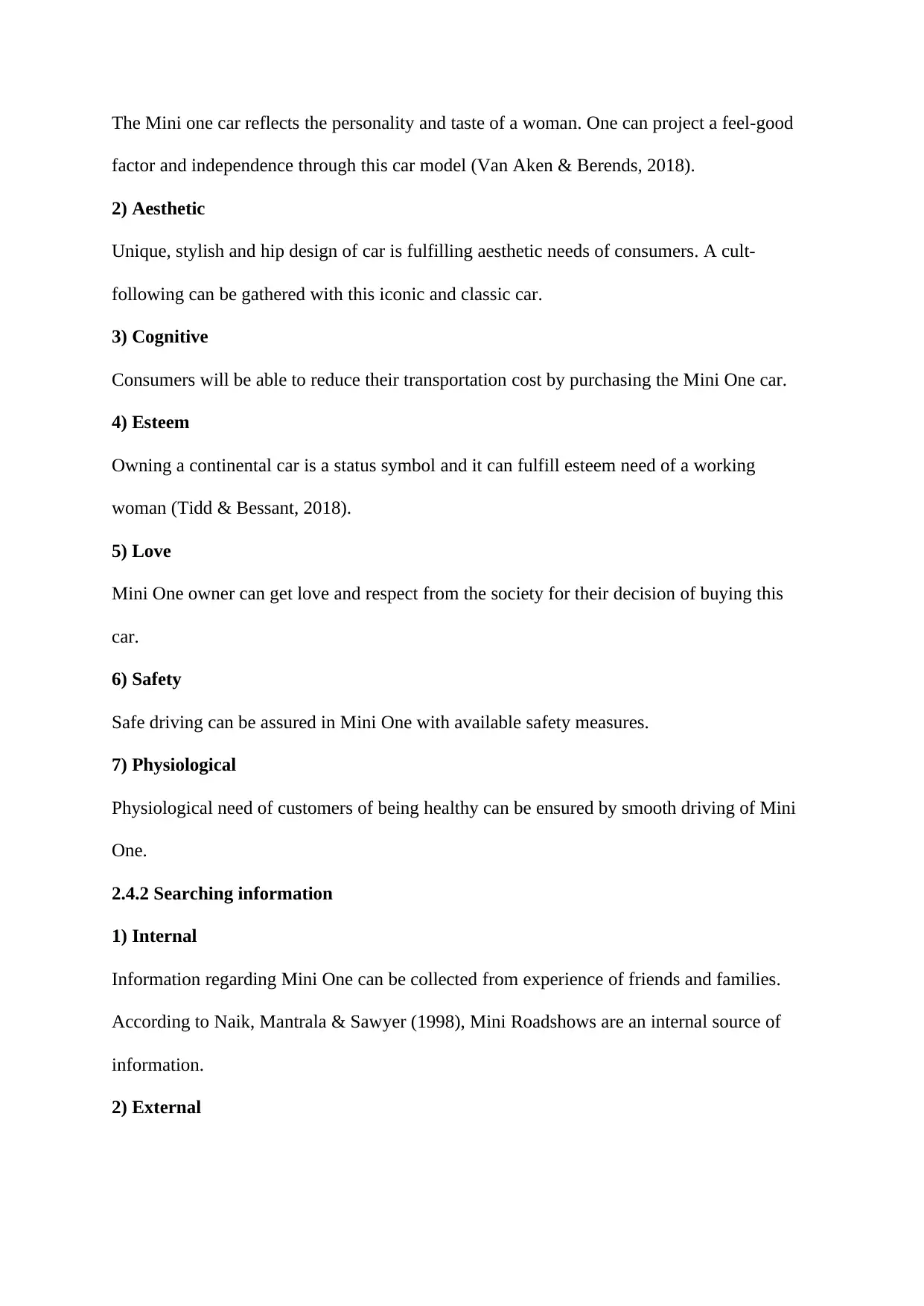
The Mini one car reflects the personality and taste of a woman. One can project a feel-good
factor and independence through this car model (Van Aken & Berends, 2018).
2) Aesthetic
Unique, stylish and hip design of car is fulfilling aesthetic needs of consumers. A cult-
following can be gathered with this iconic and classic car.
3) Cognitive
Consumers will be able to reduce their transportation cost by purchasing the Mini One car.
4) Esteem
Owning a continental car is a status symbol and it can fulfill esteem need of a working
woman (Tidd & Bessant, 2018).
5) Love
Mini One owner can get love and respect from the society for their decision of buying this
car.
6) Safety
Safe driving can be assured in Mini One with available safety measures.
7) Physiological
Physiological need of customers of being healthy can be ensured by smooth driving of Mini
One.
2.4.2 Searching information
1) Internal
Information regarding Mini One can be collected from experience of friends and families.
According to Naik, Mantrala & Sawyer (1998), Mini Roadshows are an internal source of
information.
2) External
factor and independence through this car model (Van Aken & Berends, 2018).
2) Aesthetic
Unique, stylish and hip design of car is fulfilling aesthetic needs of consumers. A cult-
following can be gathered with this iconic and classic car.
3) Cognitive
Consumers will be able to reduce their transportation cost by purchasing the Mini One car.
4) Esteem
Owning a continental car is a status symbol and it can fulfill esteem need of a working
woman (Tidd & Bessant, 2018).
5) Love
Mini One owner can get love and respect from the society for their decision of buying this
car.
6) Safety
Safe driving can be assured in Mini One with available safety measures.
7) Physiological
Physiological need of customers of being healthy can be ensured by smooth driving of Mini
One.
2.4.2 Searching information
1) Internal
Information regarding Mini One can be collected from experience of friends and families.
According to Naik, Mantrala & Sawyer (1998), Mini Roadshows are an internal source of
information.
2) External
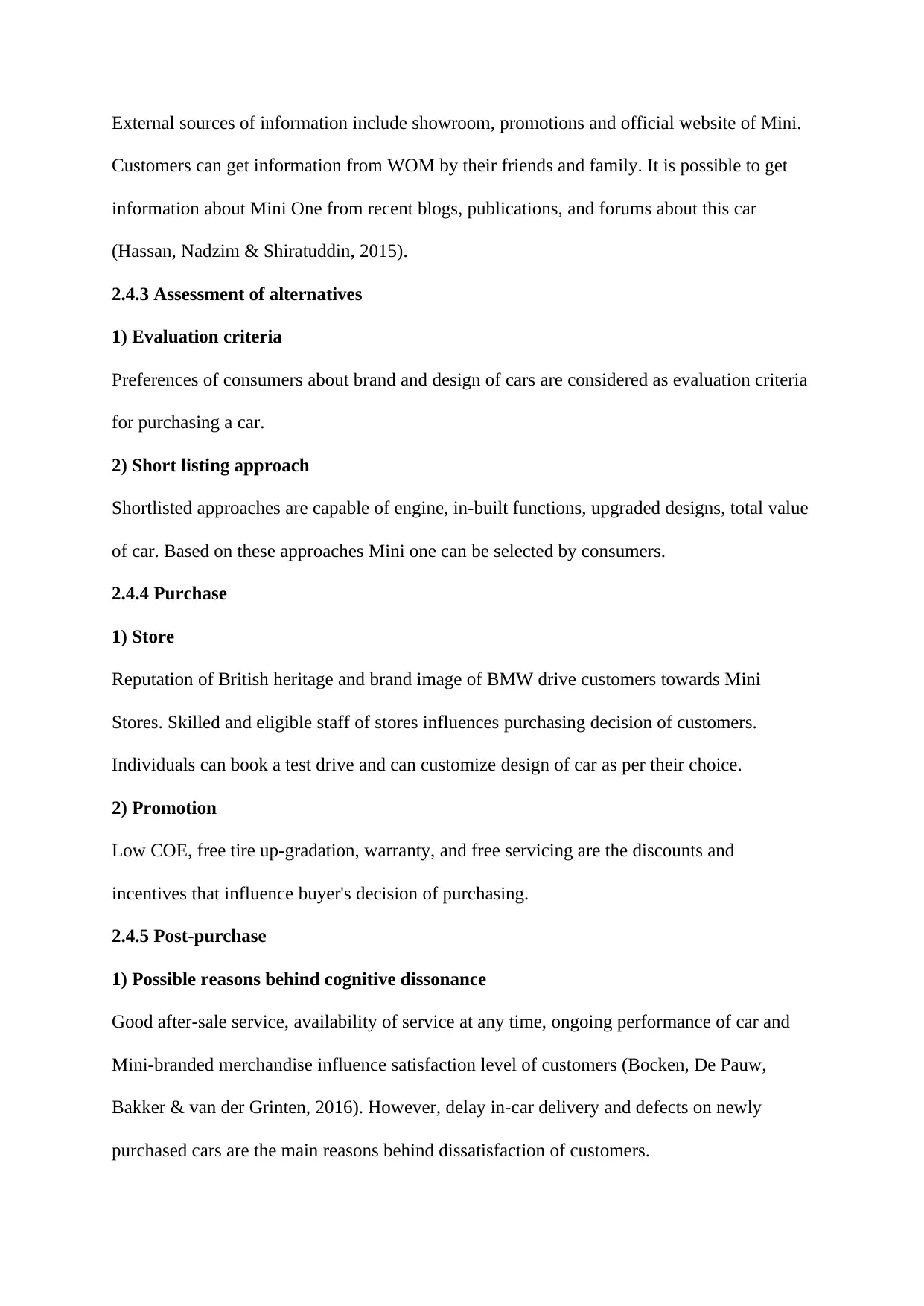
External sources of information include showroom, promotions and official website of Mini.
Customers can get information from WOM by their friends and family. It is possible to get
information about Mini One from recent blogs, publications, and forums about this car
(Hassan, Nadzim & Shiratuddin, 2015).
2.4.3 Assessment of alternatives
1) Evaluation criteria
Preferences of consumers about brand and design of cars are considered as evaluation criteria
for purchasing a car.
2) Short listing approach
Shortlisted approaches are capable of engine, in-built functions, upgraded designs, total value
of car. Based on these approaches Mini one can be selected by consumers.
2.4.4 Purchase
1) Store
Reputation of British heritage and brand image of BMW drive customers towards Mini
Stores. Skilled and eligible staff of stores influences purchasing decision of customers.
Individuals can book a test drive and can customize design of car as per their choice.
2) Promotion
Low COE, free tire up-gradation, warranty, and free servicing are the discounts and
incentives that influence buyer's decision of purchasing.
2.4.5 Post-purchase
1) Possible reasons behind cognitive dissonance
Good after-sale service, availability of service at any time, ongoing performance of car and
Mini-branded merchandise influence satisfaction level of customers (Bocken, De Pauw,
Bakker & van der Grinten, 2016). However, delay in-car delivery and defects on newly
purchased cars are the main reasons behind dissatisfaction of customers.
Customers can get information from WOM by their friends and family. It is possible to get
information about Mini One from recent blogs, publications, and forums about this car
(Hassan, Nadzim & Shiratuddin, 2015).
2.4.3 Assessment of alternatives
1) Evaluation criteria
Preferences of consumers about brand and design of cars are considered as evaluation criteria
for purchasing a car.
2) Short listing approach
Shortlisted approaches are capable of engine, in-built functions, upgraded designs, total value
of car. Based on these approaches Mini one can be selected by consumers.
2.4.4 Purchase
1) Store
Reputation of British heritage and brand image of BMW drive customers towards Mini
Stores. Skilled and eligible staff of stores influences purchasing decision of customers.
Individuals can book a test drive and can customize design of car as per their choice.
2) Promotion
Low COE, free tire up-gradation, warranty, and free servicing are the discounts and
incentives that influence buyer's decision of purchasing.
2.4.5 Post-purchase
1) Possible reasons behind cognitive dissonance
Good after-sale service, availability of service at any time, ongoing performance of car and
Mini-branded merchandise influence satisfaction level of customers (Bocken, De Pauw,
Bakker & van der Grinten, 2016). However, delay in-car delivery and defects on newly
purchased cars are the main reasons behind dissatisfaction of customers.
Paraphrase This Document
Need a fresh take? Get an instant paraphrase of this document with our AI Paraphraser
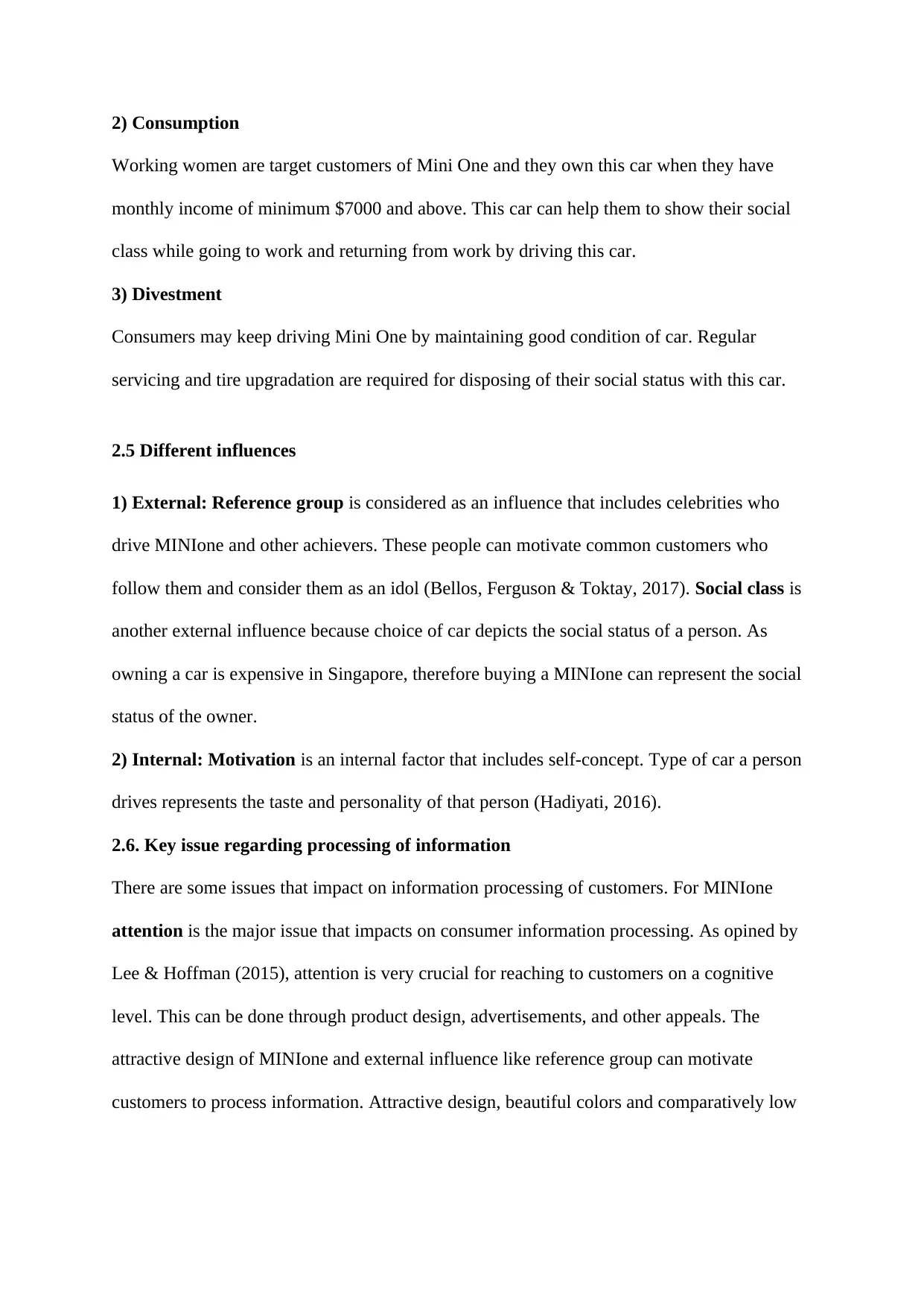
2) Consumption
Working women are target customers of Mini One and they own this car when they have
monthly income of minimum $7000 and above. This car can help them to show their social
class while going to work and returning from work by driving this car.
3) Divestment
Consumers may keep driving Mini One by maintaining good condition of car. Regular
servicing and tire upgradation are required for disposing of their social status with this car.
2.5 Different influences
1) External: Reference group is considered as an influence that includes celebrities who
drive MINIone and other achievers. These people can motivate common customers who
follow them and consider them as an idol (Bellos, Ferguson & Toktay, 2017). Social class is
another external influence because choice of car depicts the social status of a person. As
owning a car is expensive in Singapore, therefore buying a MINIone can represent the social
status of the owner.
2) Internal: Motivation is an internal factor that includes self-concept. Type of car a person
drives represents the taste and personality of that person (Hadiyati, 2016).
2.6. Key issue regarding processing of information
There are some issues that impact on information processing of customers. For MINIone
attention is the major issue that impacts on consumer information processing. As opined by
Lee & Hoffman (2015), attention is very crucial for reaching to customers on a cognitive
level. This can be done through product design, advertisements, and other appeals. The
attractive design of MINIone and external influence like reference group can motivate
customers to process information. Attractive design, beautiful colors and comparatively low
Working women are target customers of Mini One and they own this car when they have
monthly income of minimum $7000 and above. This car can help them to show their social
class while going to work and returning from work by driving this car.
3) Divestment
Consumers may keep driving Mini One by maintaining good condition of car. Regular
servicing and tire upgradation are required for disposing of their social status with this car.
2.5 Different influences
1) External: Reference group is considered as an influence that includes celebrities who
drive MINIone and other achievers. These people can motivate common customers who
follow them and consider them as an idol (Bellos, Ferguson & Toktay, 2017). Social class is
another external influence because choice of car depicts the social status of a person. As
owning a car is expensive in Singapore, therefore buying a MINIone can represent the social
status of the owner.
2) Internal: Motivation is an internal factor that includes self-concept. Type of car a person
drives represents the taste and personality of that person (Hadiyati, 2016).
2.6. Key issue regarding processing of information
There are some issues that impact on information processing of customers. For MINIone
attention is the major issue that impacts on consumer information processing. As opined by
Lee & Hoffman (2015), attention is very crucial for reaching to customers on a cognitive
level. This can be done through product design, advertisements, and other appeals. The
attractive design of MINIone and external influence like reference group can motivate
customers to process information. Attractive design, beautiful colors and comparatively low
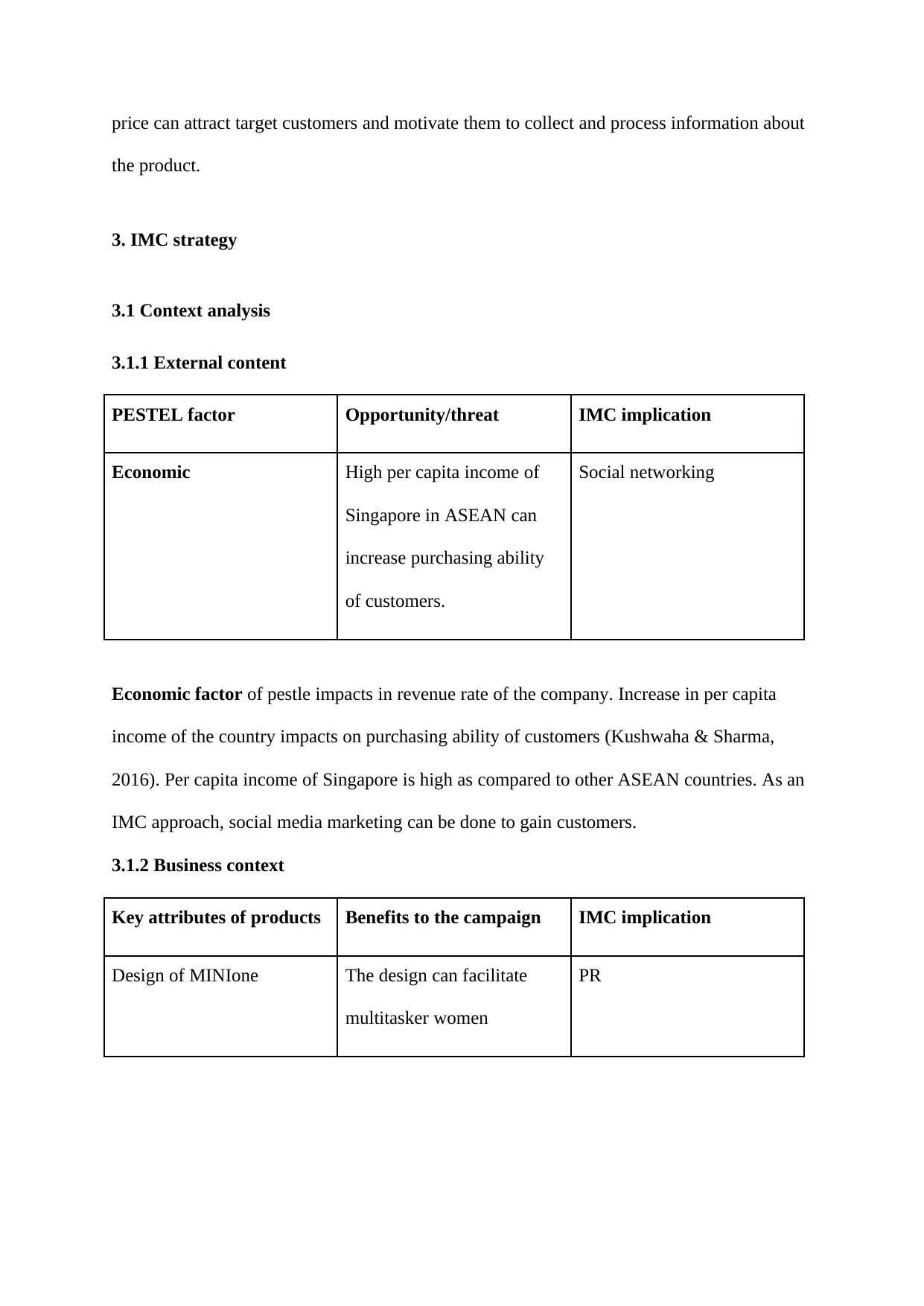
price can attract target customers and motivate them to collect and process information about
the product.
3. IMC strategy
3.1 Context analysis
3.1.1 External content
PESTEL factor Opportunity/threat IMC implication
Economic High per capita income of
Singapore in ASEAN can
increase purchasing ability
of customers.
Social networking
Economic factor of pestle impacts in revenue rate of the company. Increase in per capita
income of the country impacts on purchasing ability of customers (Kushwaha & Sharma,
2016). Per capita income of Singapore is high as compared to other ASEAN countries. As an
IMC approach, social media marketing can be done to gain customers.
3.1.2 Business context
Key attributes of products Benefits to the campaign IMC implication
Design of MINIone The design can facilitate
multitasker women
PR
the product.
3. IMC strategy
3.1 Context analysis
3.1.1 External content
PESTEL factor Opportunity/threat IMC implication
Economic High per capita income of
Singapore in ASEAN can
increase purchasing ability
of customers.
Social networking
Economic factor of pestle impacts in revenue rate of the company. Increase in per capita
income of the country impacts on purchasing ability of customers (Kushwaha & Sharma,
2016). Per capita income of Singapore is high as compared to other ASEAN countries. As an
IMC approach, social media marketing can be done to gain customers.
3.1.2 Business context
Key attributes of products Benefits to the campaign IMC implication
Design of MINIone The design can facilitate
multitasker women
PR

Design of the product can help the campaign to gain leverage. Design of the car can fulfill
various needs of modern multi-tasker women. Public relations can be adopted as an
integrated marketing communication approach in this case.
3.1.3 Customer context
CDP Key Learning IMC Implication
Problem Solving Motivation of customers - Reward on purchase
- Using proper emotional
message
various needs of modern multi-tasker women. Public relations can be adopted as an
integrated marketing communication approach in this case.
3.1.3 Customer context
CDP Key Learning IMC Implication
Problem Solving Motivation of customers - Reward on purchase
- Using proper emotional
message
Secure Best Marks with AI Grader
Need help grading? Try our AI Grader for instant feedback on your assignments.
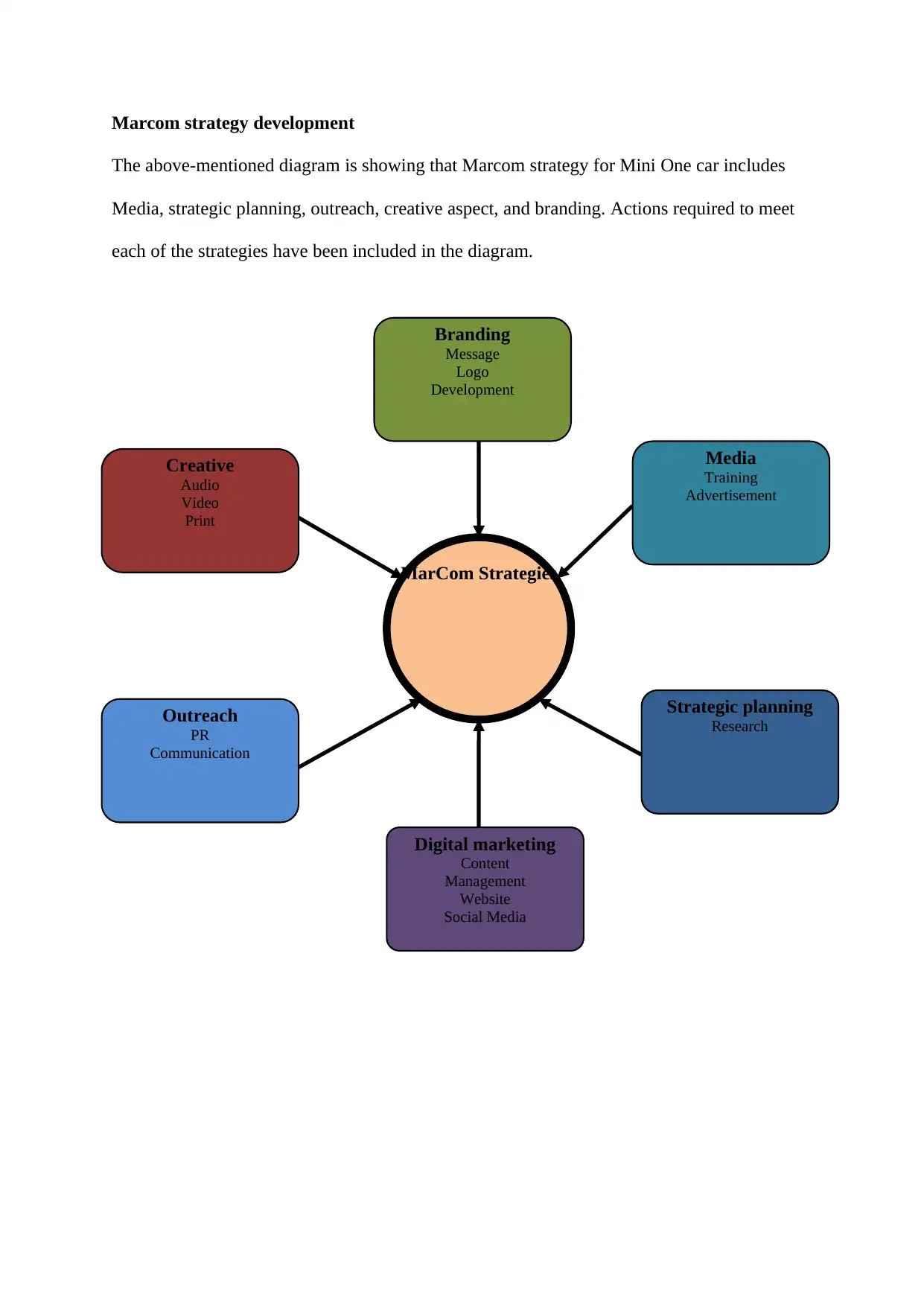
MarCom Strategies
Strategic planning
Research
Outreach
PR
Communication
Creative
Audio
Video
Print
Media
Training
Advertisement
Branding
Message
Logo
Development
Digital marketing
Content
Management
Website
Social Media
Marcom strategy development
The above-mentioned diagram is showing that Marcom strategy for Mini One car includes
Media, strategic planning, outreach, creative aspect, and branding. Actions required to meet
each of the strategies have been included in the diagram.
Strategic planning
Research
Outreach
PR
Communication
Creative
Audio
Video
Media
Training
Advertisement
Branding
Message
Logo
Development
Digital marketing
Content
Management
Website
Social Media
Marcom strategy development
The above-mentioned diagram is showing that Marcom strategy for Mini One car includes
Media, strategic planning, outreach, creative aspect, and branding. Actions required to meet
each of the strategies have been included in the diagram.
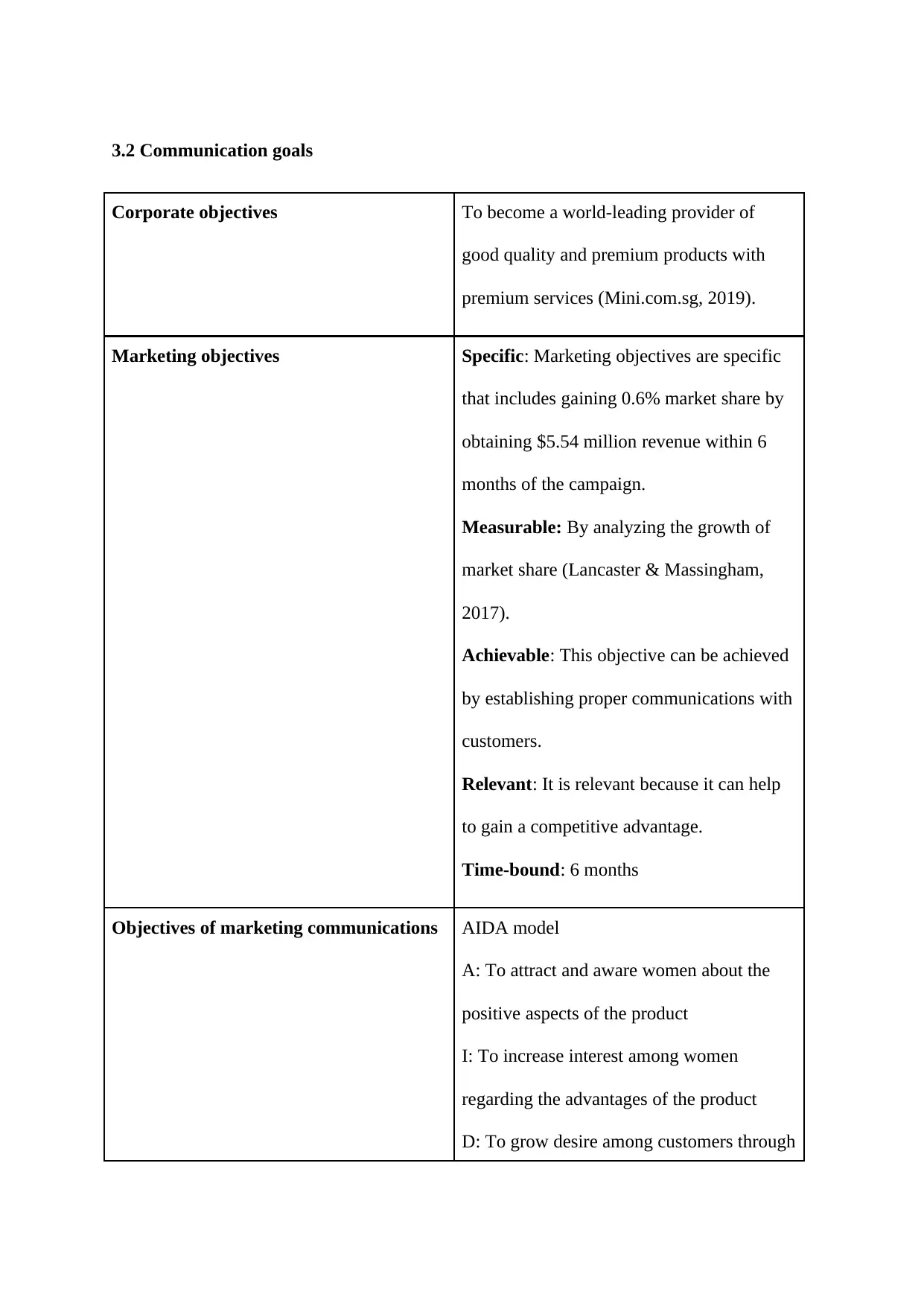
3.2 Communication goals
Corporate objectives To become a world-leading provider of
good quality and premium products with
premium services (Mini.com.sg, 2019).
Marketing objectives Specific: Marketing objectives are specific
that includes gaining 0.6% market share by
obtaining $5.54 million revenue within 6
months of the campaign.
Measurable: By analyzing the growth of
market share (Lancaster & Massingham,
2017).
Achievable: This objective can be achieved
by establishing proper communications with
customers.
Relevant: It is relevant because it can help
to gain a competitive advantage.
Time-bound: 6 months
Objectives of marketing communications AIDA model
A: To attract and aware women about the
positive aspects of the product
I: To increase interest among women
regarding the advantages of the product
D: To grow desire among customers through
Corporate objectives To become a world-leading provider of
good quality and premium products with
premium services (Mini.com.sg, 2019).
Marketing objectives Specific: Marketing objectives are specific
that includes gaining 0.6% market share by
obtaining $5.54 million revenue within 6
months of the campaign.
Measurable: By analyzing the growth of
market share (Lancaster & Massingham,
2017).
Achievable: This objective can be achieved
by establishing proper communications with
customers.
Relevant: It is relevant because it can help
to gain a competitive advantage.
Time-bound: 6 months
Objectives of marketing communications AIDA model
A: To attract and aware women about the
positive aspects of the product
I: To increase interest among women
regarding the advantages of the product
D: To grow desire among customers through
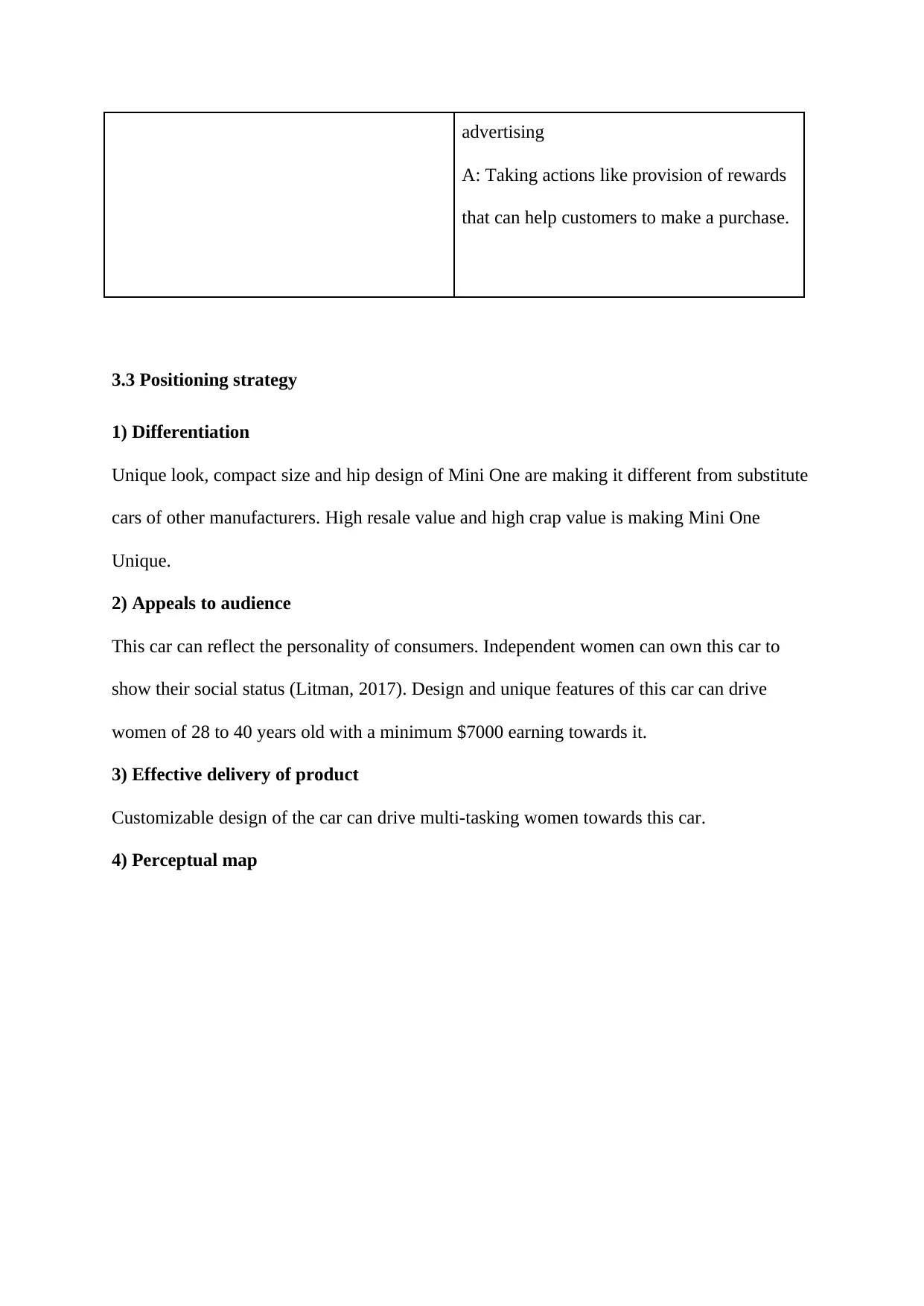
advertising
A: Taking actions like provision of rewards
that can help customers to make a purchase.
3.3 Positioning strategy
1) Differentiation
Unique look, compact size and hip design of Mini One are making it different from substitute
cars of other manufacturers. High resale value and high crap value is making Mini One
Unique.
2) Appeals to audience
This car can reflect the personality of consumers. Independent women can own this car to
show their social status (Litman, 2017). Design and unique features of this car can drive
women of 28 to 40 years old with a minimum $7000 earning towards it.
3) Effective delivery of product
Customizable design of the car can drive multi-tasking women towards this car.
4) Perceptual map
A: Taking actions like provision of rewards
that can help customers to make a purchase.
3.3 Positioning strategy
1) Differentiation
Unique look, compact size and hip design of Mini One are making it different from substitute
cars of other manufacturers. High resale value and high crap value is making Mini One
Unique.
2) Appeals to audience
This car can reflect the personality of consumers. Independent women can own this car to
show their social status (Litman, 2017). Design and unique features of this car can drive
women of 28 to 40 years old with a minimum $7000 earning towards it.
3) Effective delivery of product
Customizable design of the car can drive multi-tasking women towards this car.
4) Perceptual map
Paraphrase This Document
Need a fresh take? Get an instant paraphrase of this document with our AI Paraphraser
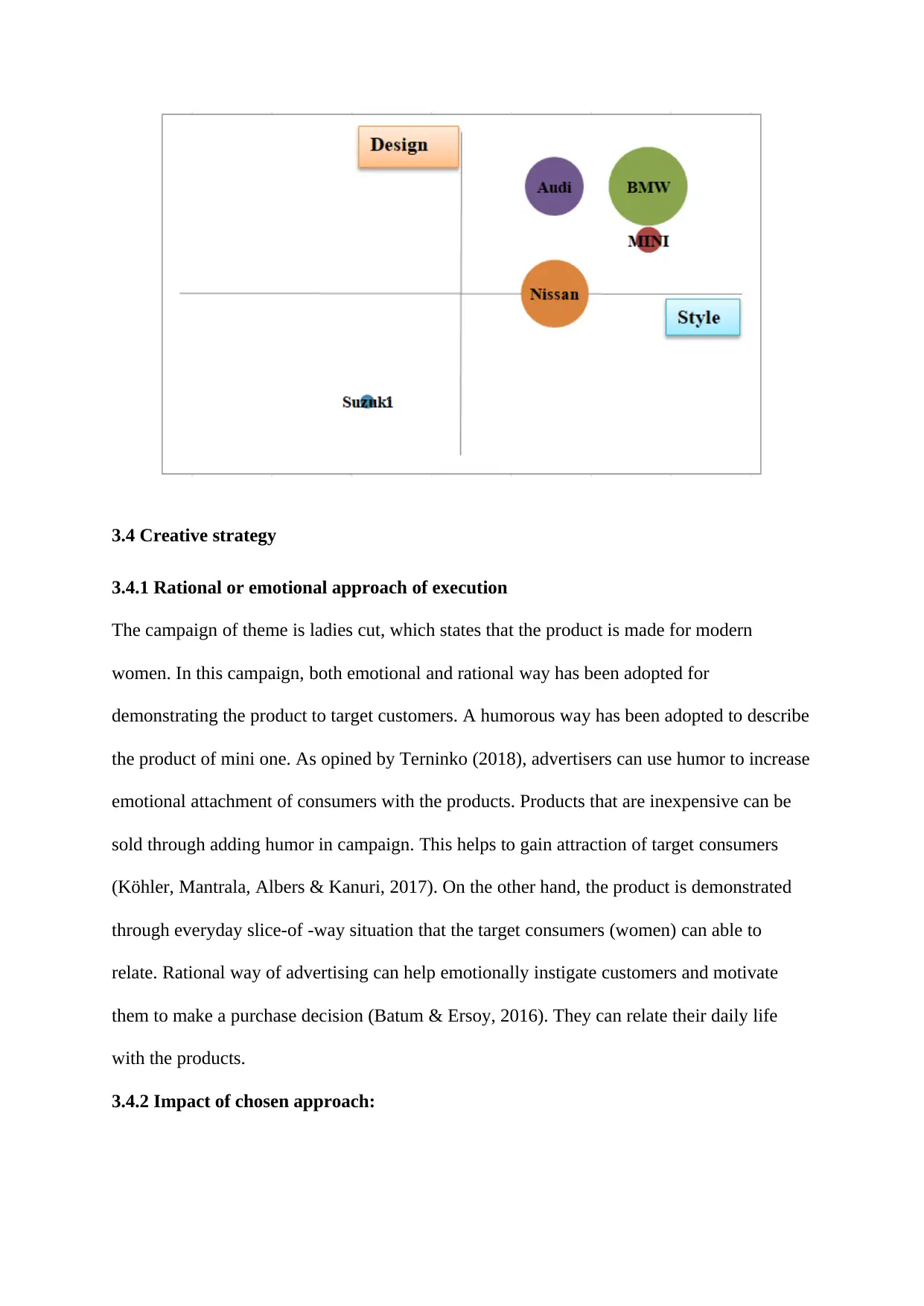
3.4 Creative strategy
3.4.1 Rational or emotional approach of execution
The campaign of theme is ladies cut, which states that the product is made for modern
women. In this campaign, both emotional and rational way has been adopted for
demonstrating the product to target customers. A humorous way has been adopted to describe
the product of mini one. As opined by Terninko (2018), advertisers can use humor to increase
emotional attachment of consumers with the products. Products that are inexpensive can be
sold through adding humor in campaign. This helps to gain attraction of target consumers
(Köhler, Mantrala, Albers & Kanuri, 2017). On the other hand, the product is demonstrated
through everyday slice-of -way situation that the target consumers (women) can able to
relate. Rational way of advertising can help emotionally instigate customers and motivate
them to make a purchase decision (Batum & Ersoy, 2016). They can relate their daily life
with the products.
3.4.2 Impact of chosen approach:
3.4.1 Rational or emotional approach of execution
The campaign of theme is ladies cut, which states that the product is made for modern
women. In this campaign, both emotional and rational way has been adopted for
demonstrating the product to target customers. A humorous way has been adopted to describe
the product of mini one. As opined by Terninko (2018), advertisers can use humor to increase
emotional attachment of consumers with the products. Products that are inexpensive can be
sold through adding humor in campaign. This helps to gain attraction of target consumers
(Köhler, Mantrala, Albers & Kanuri, 2017). On the other hand, the product is demonstrated
through everyday slice-of -way situation that the target consumers (women) can able to
relate. Rational way of advertising can help emotionally instigate customers and motivate
them to make a purchase decision (Batum & Ersoy, 2016). They can relate their daily life
with the products.
3.4.2 Impact of chosen approach:
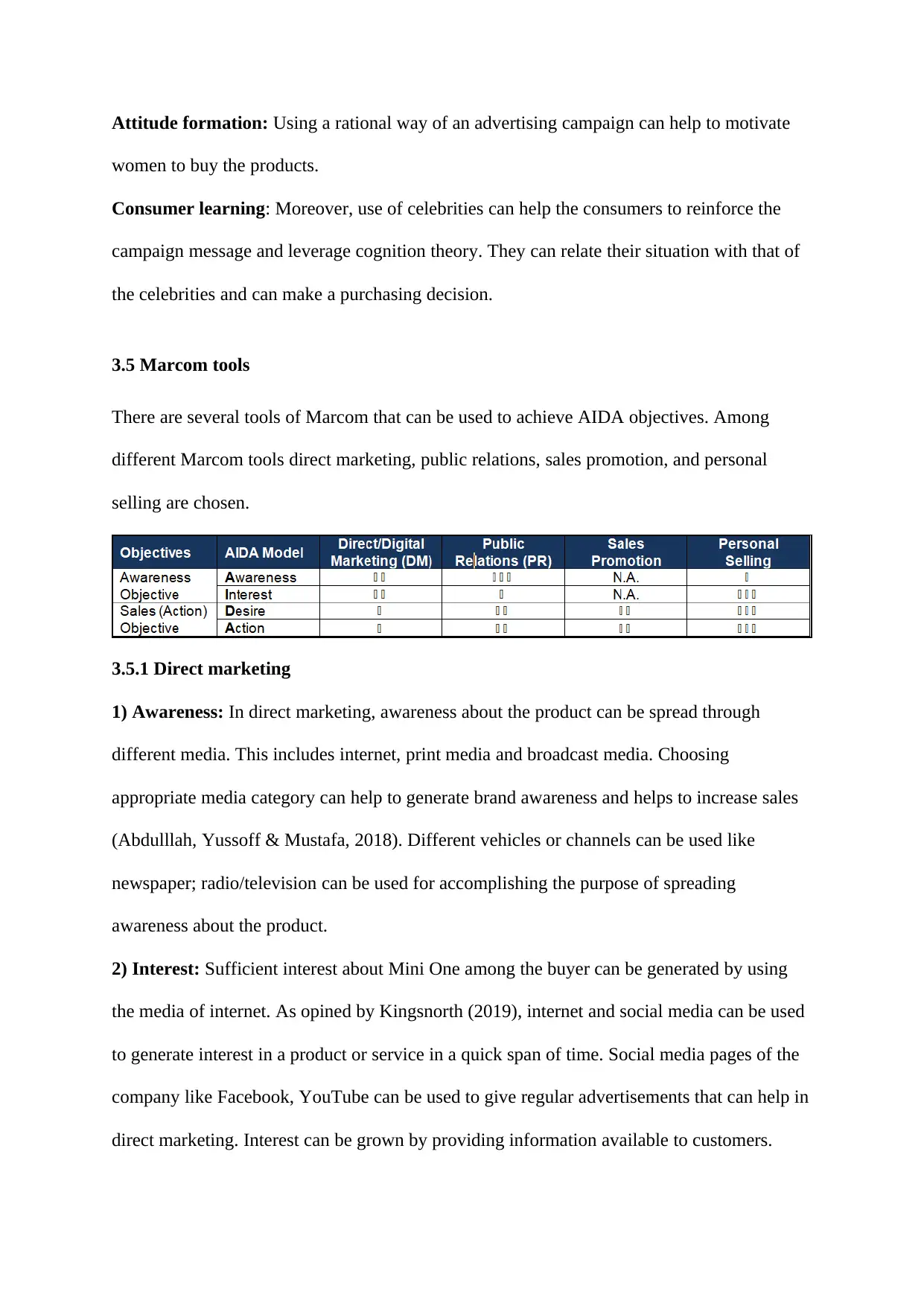
Attitude formation: Using a rational way of an advertising campaign can help to motivate
women to buy the products.
Consumer learning: Moreover, use of celebrities can help the consumers to reinforce the
campaign message and leverage cognition theory. They can relate their situation with that of
the celebrities and can make a purchasing decision.
3.5 Marcom tools
There are several tools of Marcom that can be used to achieve AIDA objectives. Among
different Marcom tools direct marketing, public relations, sales promotion, and personal
selling are chosen.
3.5.1 Direct marketing
1) Awareness: In direct marketing, awareness about the product can be spread through
different media. This includes internet, print media and broadcast media. Choosing
appropriate media category can help to generate brand awareness and helps to increase sales
(Abdulllah, Yussoff & Mustafa, 2018). Different vehicles or channels can be used like
newspaper; radio/television can be used for accomplishing the purpose of spreading
awareness about the product.
2) Interest: Sufficient interest about Mini One among the buyer can be generated by using
the media of internet. As opined by Kingsnorth (2019), internet and social media can be used
to generate interest in a product or service in a quick span of time. Social media pages of the
company like Facebook, YouTube can be used to give regular advertisements that can help in
direct marketing. Interest can be grown by providing information available to customers.
women to buy the products.
Consumer learning: Moreover, use of celebrities can help the consumers to reinforce the
campaign message and leverage cognition theory. They can relate their situation with that of
the celebrities and can make a purchasing decision.
3.5 Marcom tools
There are several tools of Marcom that can be used to achieve AIDA objectives. Among
different Marcom tools direct marketing, public relations, sales promotion, and personal
selling are chosen.
3.5.1 Direct marketing
1) Awareness: In direct marketing, awareness about the product can be spread through
different media. This includes internet, print media and broadcast media. Choosing
appropriate media category can help to generate brand awareness and helps to increase sales
(Abdulllah, Yussoff & Mustafa, 2018). Different vehicles or channels can be used like
newspaper; radio/television can be used for accomplishing the purpose of spreading
awareness about the product.
2) Interest: Sufficient interest about Mini One among the buyer can be generated by using
the media of internet. As opined by Kingsnorth (2019), internet and social media can be used
to generate interest in a product or service in a quick span of time. Social media pages of the
company like Facebook, YouTube can be used to give regular advertisements that can help in
direct marketing. Interest can be grown by providing information available to customers.
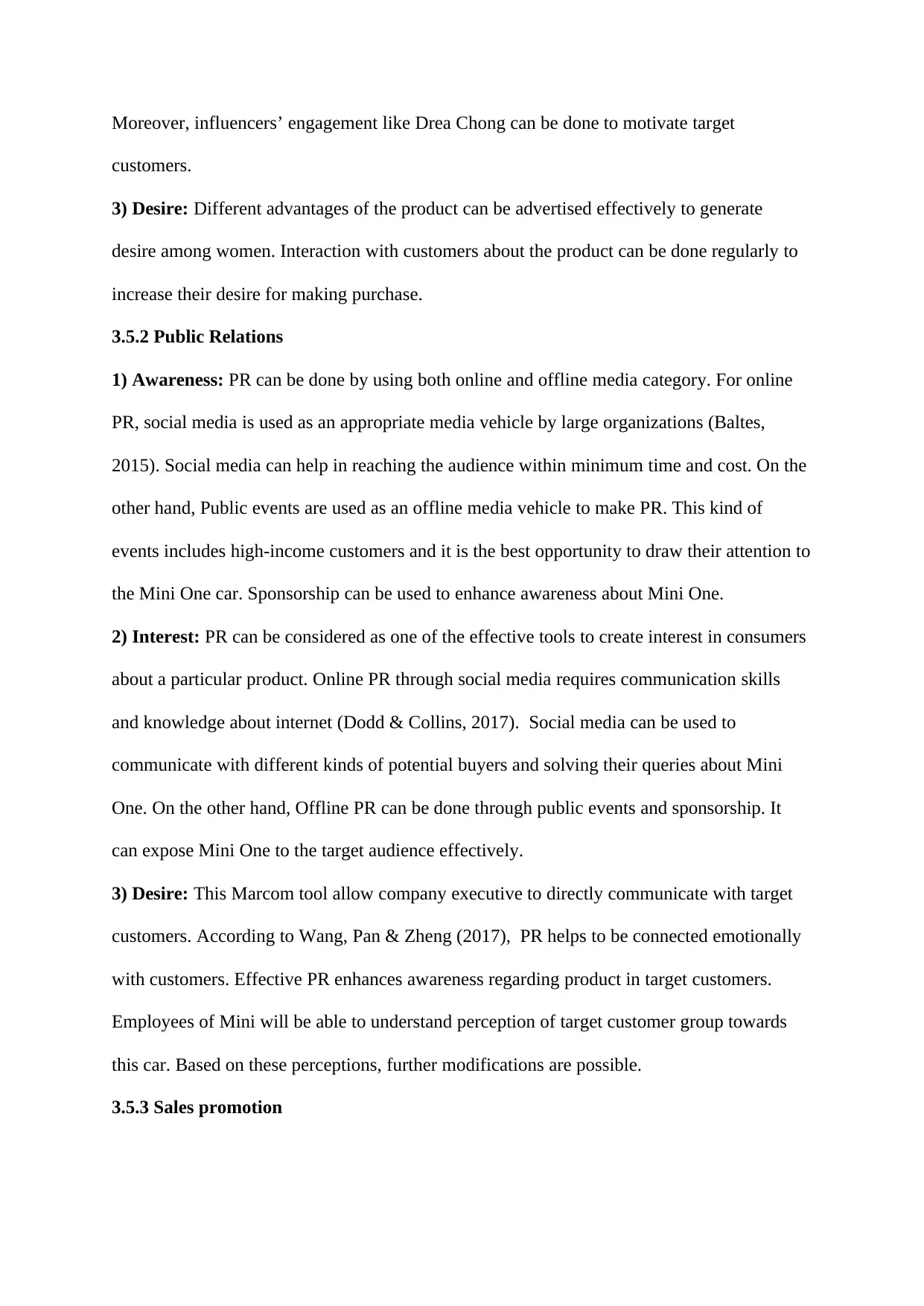
Moreover, influencers’ engagement like Drea Chong can be done to motivate target
customers.
3) Desire: Different advantages of the product can be advertised effectively to generate
desire among women. Interaction with customers about the product can be done regularly to
increase their desire for making purchase.
3.5.2 Public Relations
1) Awareness: PR can be done by using both online and offline media category. For online
PR, social media is used as an appropriate media vehicle by large organizations (Baltes,
2015). Social media can help in reaching the audience within minimum time and cost. On the
other hand, Public events are used as an offline media vehicle to make PR. This kind of
events includes high-income customers and it is the best opportunity to draw their attention to
the Mini One car. Sponsorship can be used to enhance awareness about Mini One.
2) Interest: PR can be considered as one of the effective tools to create interest in consumers
about a particular product. Online PR through social media requires communication skills
and knowledge about internet (Dodd & Collins, 2017). Social media can be used to
communicate with different kinds of potential buyers and solving their queries about Mini
One. On the other hand, Offline PR can be done through public events and sponsorship. It
can expose Mini One to the target audience effectively.
3) Desire: This Marcom tool allow company executive to directly communicate with target
customers. According to Wang, Pan & Zheng (2017), PR helps to be connected emotionally
with customers. Effective PR enhances awareness regarding product in target customers.
Employees of Mini will be able to understand perception of target customer group towards
this car. Based on these perceptions, further modifications are possible.
3.5.3 Sales promotion
customers.
3) Desire: Different advantages of the product can be advertised effectively to generate
desire among women. Interaction with customers about the product can be done regularly to
increase their desire for making purchase.
3.5.2 Public Relations
1) Awareness: PR can be done by using both online and offline media category. For online
PR, social media is used as an appropriate media vehicle by large organizations (Baltes,
2015). Social media can help in reaching the audience within minimum time and cost. On the
other hand, Public events are used as an offline media vehicle to make PR. This kind of
events includes high-income customers and it is the best opportunity to draw their attention to
the Mini One car. Sponsorship can be used to enhance awareness about Mini One.
2) Interest: PR can be considered as one of the effective tools to create interest in consumers
about a particular product. Online PR through social media requires communication skills
and knowledge about internet (Dodd & Collins, 2017). Social media can be used to
communicate with different kinds of potential buyers and solving their queries about Mini
One. On the other hand, Offline PR can be done through public events and sponsorship. It
can expose Mini One to the target audience effectively.
3) Desire: This Marcom tool allow company executive to directly communicate with target
customers. According to Wang, Pan & Zheng (2017), PR helps to be connected emotionally
with customers. Effective PR enhances awareness regarding product in target customers.
Employees of Mini will be able to understand perception of target customer group towards
this car. Based on these perceptions, further modifications are possible.
3.5.3 Sales promotion
Secure Best Marks with AI Grader
Need help grading? Try our AI Grader for instant feedback on your assignments.
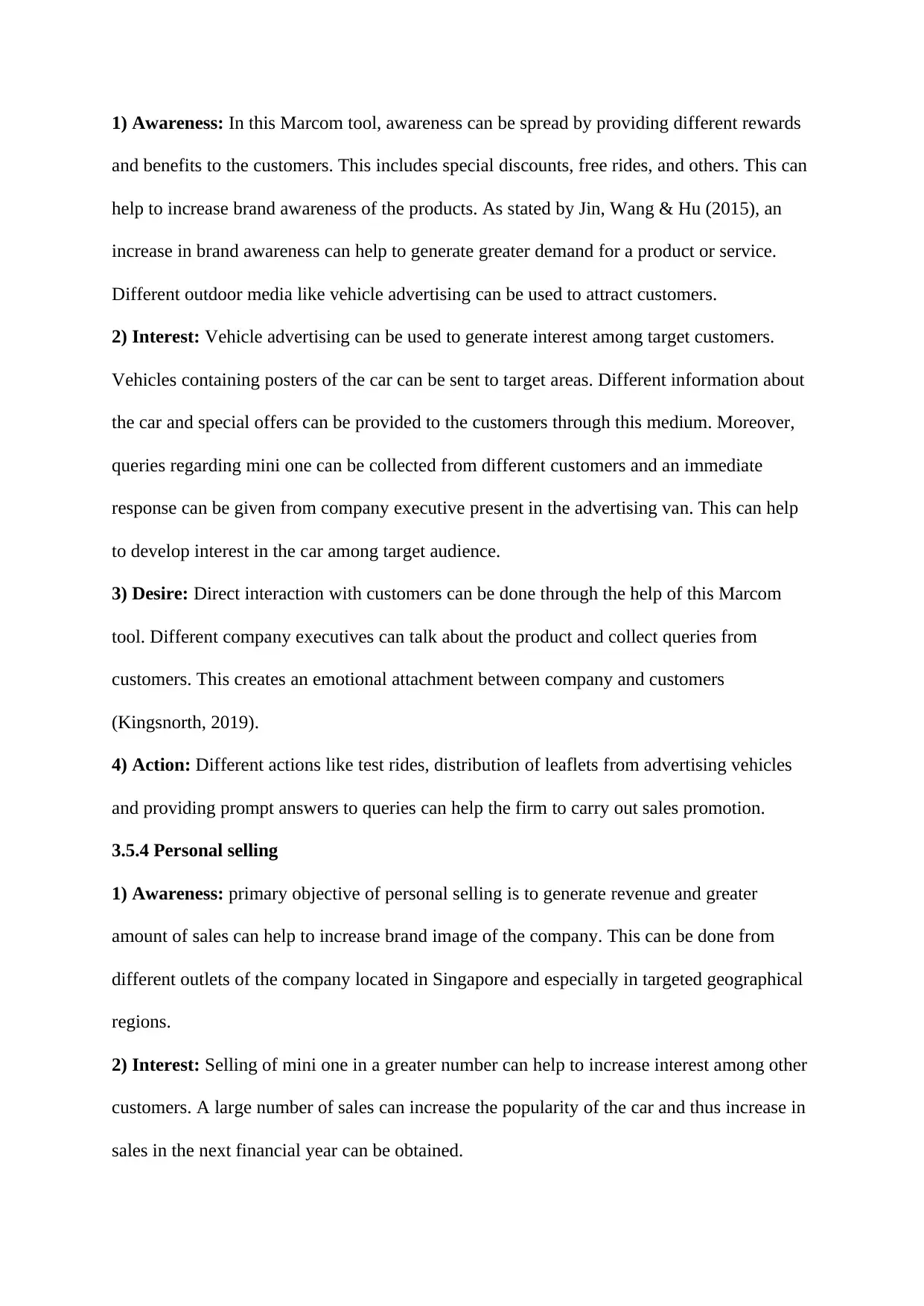
1) Awareness: In this Marcom tool, awareness can be spread by providing different rewards
and benefits to the customers. This includes special discounts, free rides, and others. This can
help to increase brand awareness of the products. As stated by Jin, Wang & Hu (2015), an
increase in brand awareness can help to generate greater demand for a product or service.
Different outdoor media like vehicle advertising can be used to attract customers.
2) Interest: Vehicle advertising can be used to generate interest among target customers.
Vehicles containing posters of the car can be sent to target areas. Different information about
the car and special offers can be provided to the customers through this medium. Moreover,
queries regarding mini one can be collected from different customers and an immediate
response can be given from company executive present in the advertising van. This can help
to develop interest in the car among target audience.
3) Desire: Direct interaction with customers can be done through the help of this Marcom
tool. Different company executives can talk about the product and collect queries from
customers. This creates an emotional attachment between company and customers
(Kingsnorth, 2019).
4) Action: Different actions like test rides, distribution of leaflets from advertising vehicles
and providing prompt answers to queries can help the firm to carry out sales promotion.
3.5.4 Personal selling
1) Awareness: primary objective of personal selling is to generate revenue and greater
amount of sales can help to increase brand image of the company. This can be done from
different outlets of the company located in Singapore and especially in targeted geographical
regions.
2) Interest: Selling of mini one in a greater number can help to increase interest among other
customers. A large number of sales can increase the popularity of the car and thus increase in
sales in the next financial year can be obtained.
and benefits to the customers. This includes special discounts, free rides, and others. This can
help to increase brand awareness of the products. As stated by Jin, Wang & Hu (2015), an
increase in brand awareness can help to generate greater demand for a product or service.
Different outdoor media like vehicle advertising can be used to attract customers.
2) Interest: Vehicle advertising can be used to generate interest among target customers.
Vehicles containing posters of the car can be sent to target areas. Different information about
the car and special offers can be provided to the customers through this medium. Moreover,
queries regarding mini one can be collected from different customers and an immediate
response can be given from company executive present in the advertising van. This can help
to develop interest in the car among target audience.
3) Desire: Direct interaction with customers can be done through the help of this Marcom
tool. Different company executives can talk about the product and collect queries from
customers. This creates an emotional attachment between company and customers
(Kingsnorth, 2019).
4) Action: Different actions like test rides, distribution of leaflets from advertising vehicles
and providing prompt answers to queries can help the firm to carry out sales promotion.
3.5.4 Personal selling
1) Awareness: primary objective of personal selling is to generate revenue and greater
amount of sales can help to increase brand image of the company. This can be done from
different outlets of the company located in Singapore and especially in targeted geographical
regions.
2) Interest: Selling of mini one in a greater number can help to increase interest among other
customers. A large number of sales can increase the popularity of the car and thus increase in
sales in the next financial year can be obtained.
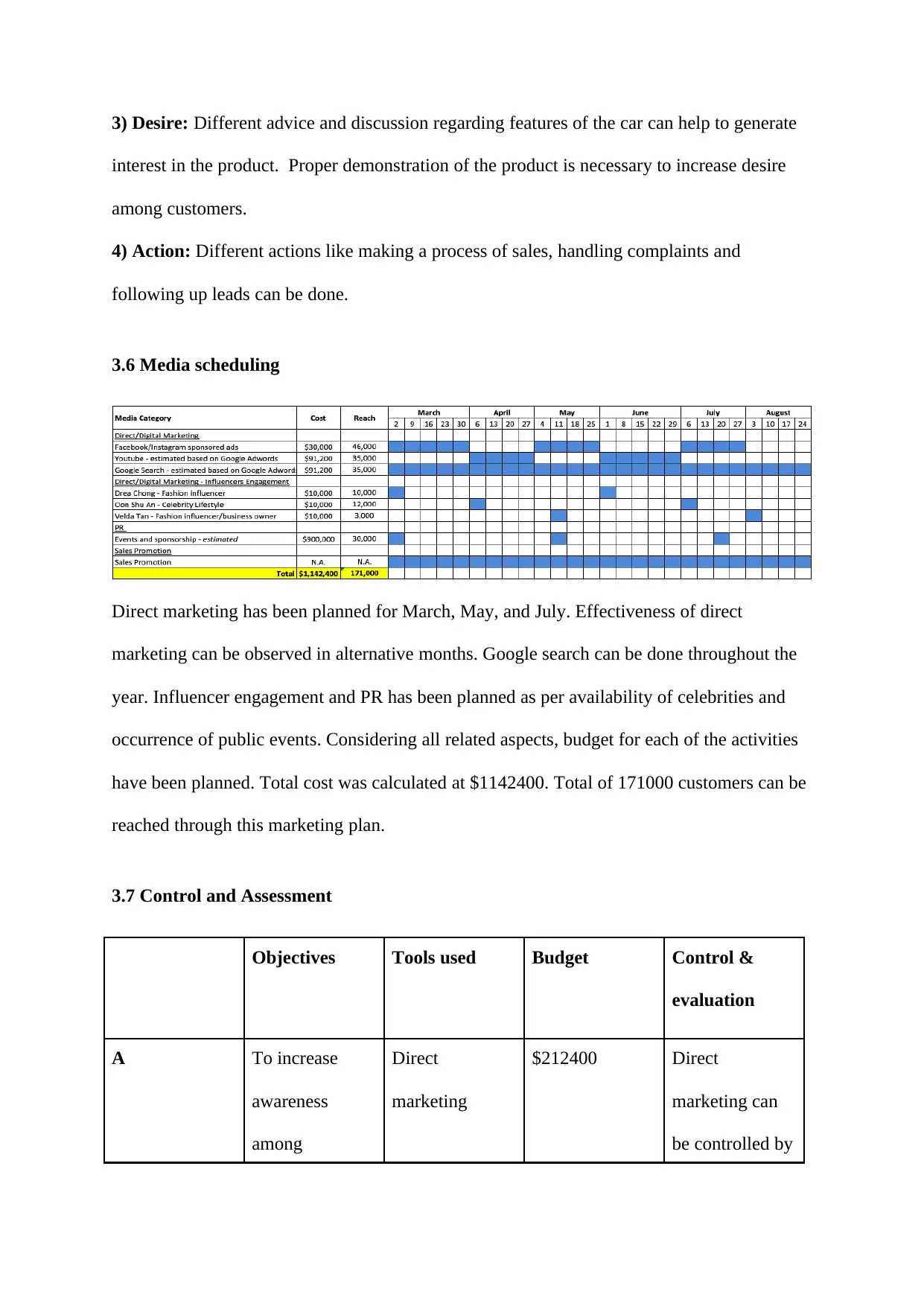
3) Desire: Different advice and discussion regarding features of the car can help to generate
interest in the product. Proper demonstration of the product is necessary to increase desire
among customers.
4) Action: Different actions like making a process of sales, handling complaints and
following up leads can be done.
3.6 Media scheduling
Direct marketing has been planned for March, May, and July. Effectiveness of direct
marketing can be observed in alternative months. Google search can be done throughout the
year. Influencer engagement and PR has been planned as per availability of celebrities and
occurrence of public events. Considering all related aspects, budget for each of the activities
have been planned. Total cost was calculated at $1142400. Total of 171000 customers can be
reached through this marketing plan.
3.7 Control and Assessment
Objectives Tools used Budget Control &
evaluation
A To increase
awareness
among
Direct
marketing
$212400 Direct
marketing can
be controlled by
interest in the product. Proper demonstration of the product is necessary to increase desire
among customers.
4) Action: Different actions like making a process of sales, handling complaints and
following up leads can be done.
3.6 Media scheduling
Direct marketing has been planned for March, May, and July. Effectiveness of direct
marketing can be observed in alternative months. Google search can be done throughout the
year. Influencer engagement and PR has been planned as per availability of celebrities and
occurrence of public events. Considering all related aspects, budget for each of the activities
have been planned. Total cost was calculated at $1142400. Total of 171000 customers can be
reached through this marketing plan.
3.7 Control and Assessment
Objectives Tools used Budget Control &
evaluation
A To increase
awareness
among
Direct
marketing
$212400 Direct
marketing can
be controlled by
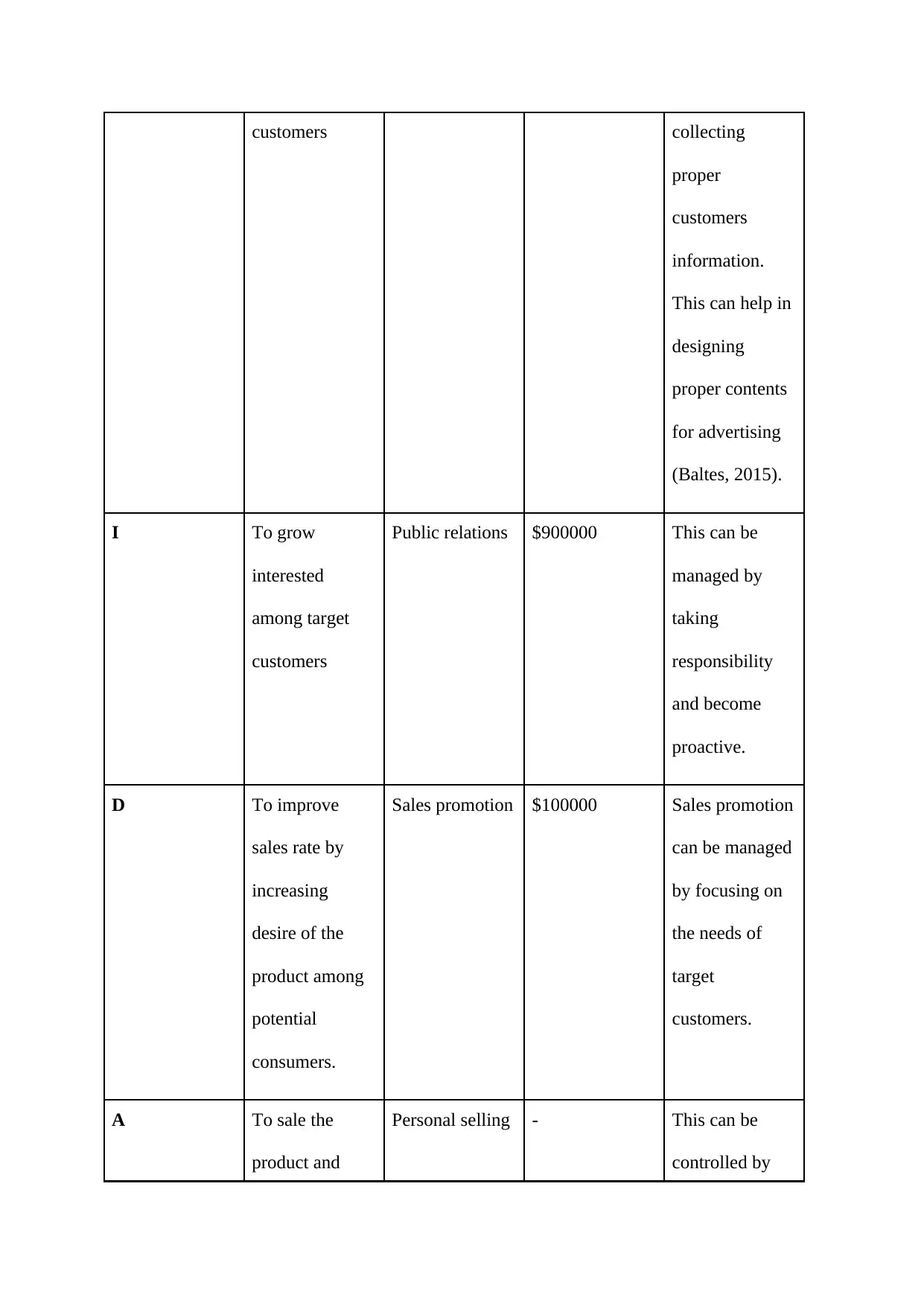
customers collecting
proper
customers
information.
This can help in
designing
proper contents
for advertising
(Baltes, 2015).
I To grow
interested
among target
customers
Public relations $900000 This can be
managed by
taking
responsibility
and become
proactive.
D To improve
sales rate by
increasing
desire of the
product among
potential
consumers.
Sales promotion $100000 Sales promotion
can be managed
by focusing on
the needs of
target
customers.
A To sale the
product and
Personal selling - This can be
controlled by
proper
customers
information.
This can help in
designing
proper contents
for advertising
(Baltes, 2015).
I To grow
interested
among target
customers
Public relations $900000 This can be
managed by
taking
responsibility
and become
proactive.
D To improve
sales rate by
increasing
desire of the
product among
potential
consumers.
Sales promotion $100000 Sales promotion
can be managed
by focusing on
the needs of
target
customers.
A To sale the
product and
Personal selling - This can be
controlled by
Paraphrase This Document
Need a fresh take? Get an instant paraphrase of this document with our AI Paraphraser
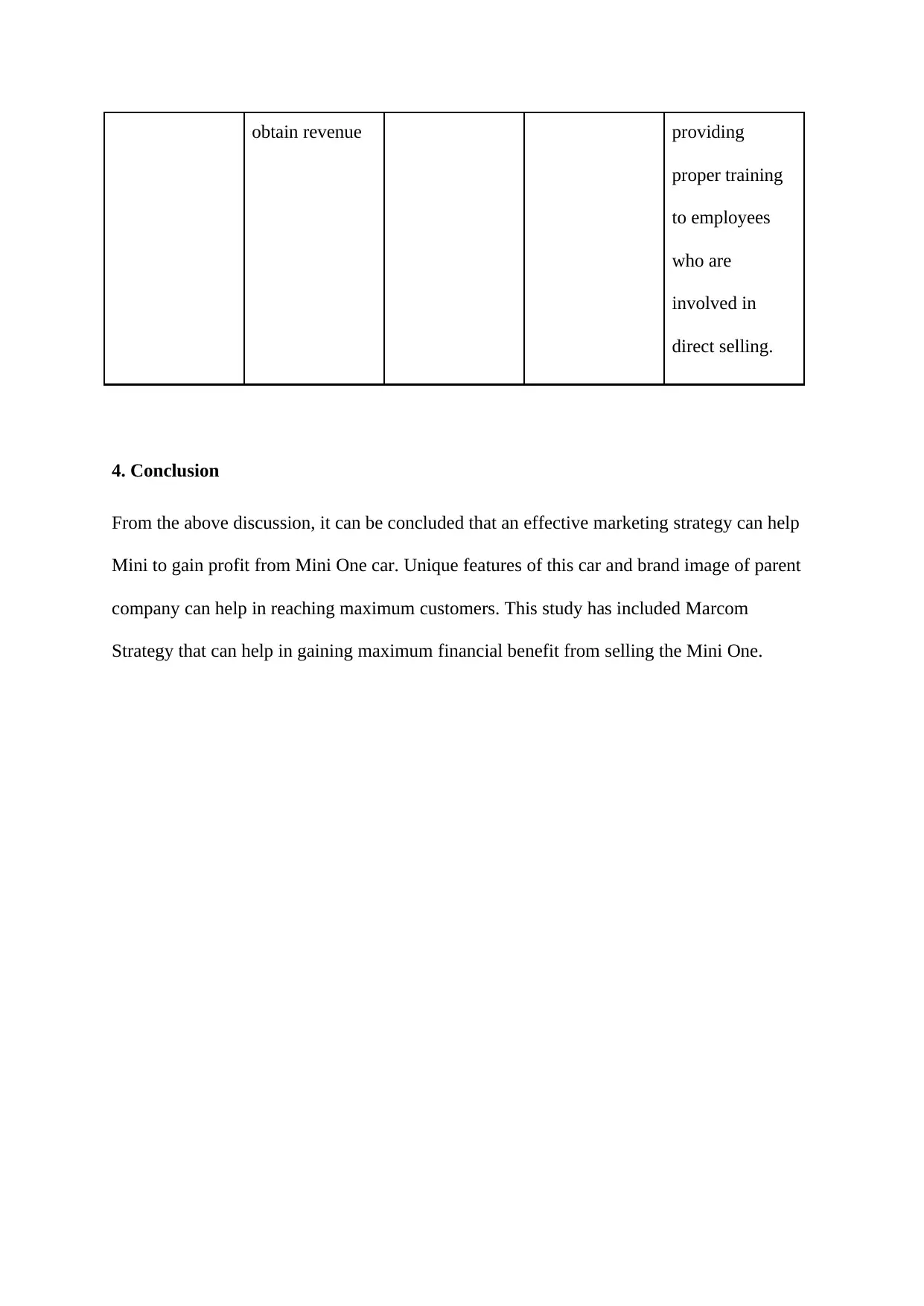
obtain revenue providing
proper training
to employees
who are
involved in
direct selling.
4. Conclusion
From the above discussion, it can be concluded that an effective marketing strategy can help
Mini to gain profit from Mini One car. Unique features of this car and brand image of parent
company can help in reaching maximum customers. This study has included Marcom
Strategy that can help in gaining maximum financial benefit from selling the Mini One.
proper training
to employees
who are
involved in
direct selling.
4. Conclusion
From the above discussion, it can be concluded that an effective marketing strategy can help
Mini to gain profit from Mini One car. Unique features of this car and brand image of parent
company can help in reaching maximum customers. This study has included Marcom
Strategy that can help in gaining maximum financial benefit from selling the Mini One.
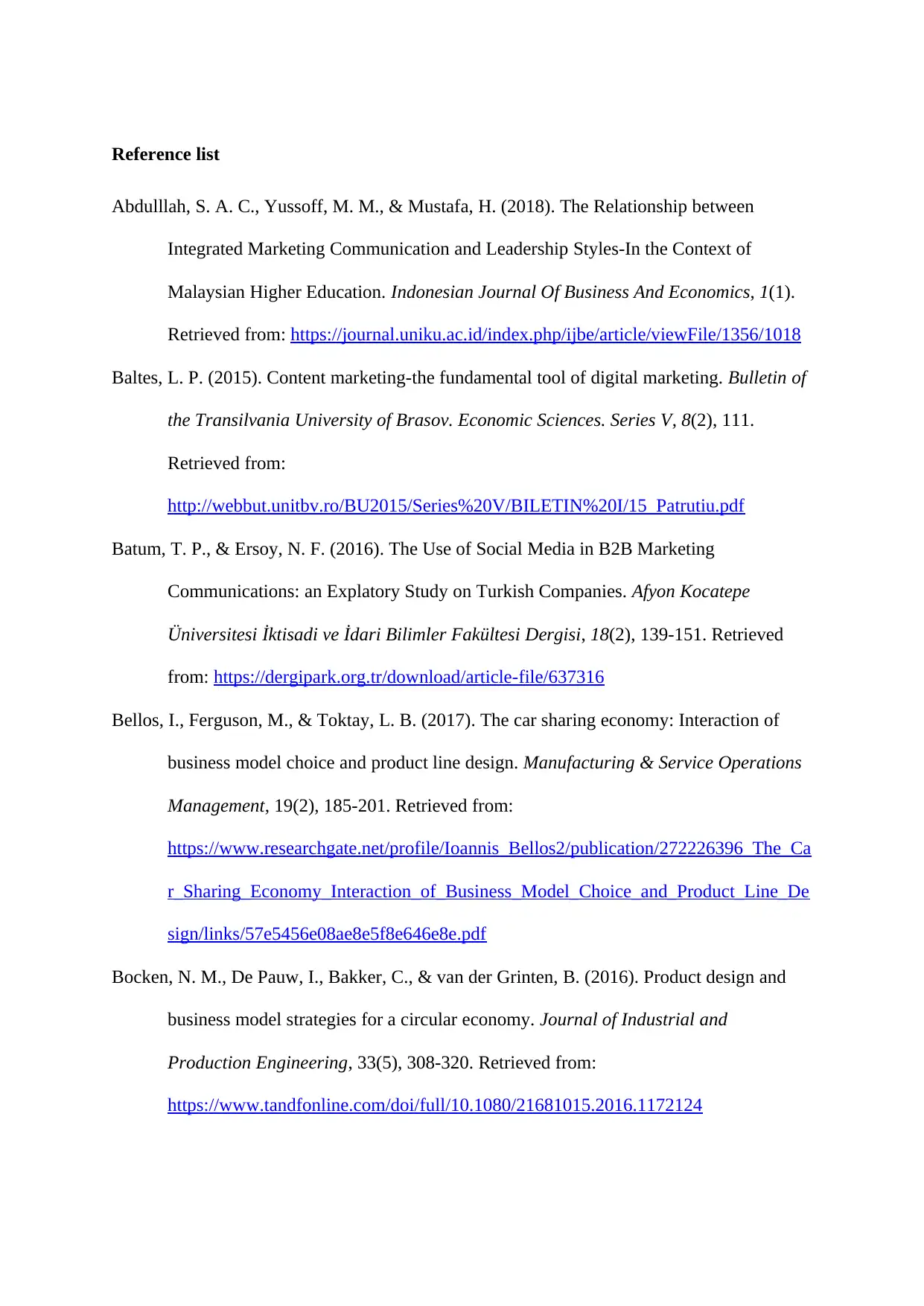
Reference list
Abdulllah, S. A. C., Yussoff, M. M., & Mustafa, H. (2018). The Relationship between
Integrated Marketing Communication and Leadership Styles-In the Context of
Malaysian Higher Education. Indonesian Journal Of Business And Economics, 1(1).
Retrieved from: https://journal.uniku.ac.id/index.php/ijbe/article/viewFile/1356/1018
Baltes, L. P. (2015). Content marketing-the fundamental tool of digital marketing. Bulletin of
the Transilvania University of Brasov. Economic Sciences. Series V, 8(2), 111.
Retrieved from:
http://webbut.unitbv.ro/BU2015/Series%20V/BILETIN%20I/15_Patrutiu.pdf
Batum, T. P., & Ersoy, N. F. (2016). The Use of Social Media in B2B Marketing
Communications: an Explatory Study on Turkish Companies. Afyon Kocatepe
Üniversitesi İktisadi ve İdari Bilimler Fakültesi Dergisi, 18(2), 139-151. Retrieved
from: https://dergipark.org.tr/download/article-file/637316
Bellos, I., Ferguson, M., & Toktay, L. B. (2017). The car sharing economy: Interaction of
business model choice and product line design. Manufacturing & Service Operations
Management, 19(2), 185-201. Retrieved from:
https://www.researchgate.net/profile/Ioannis_Bellos2/publication/272226396_The_Ca
r_Sharing_Economy_Interaction_of_Business_Model_Choice_and_Product_Line_De
sign/links/57e5456e08ae8e5f8e646e8e.pdf
Bocken, N. M., De Pauw, I., Bakker, C., & van der Grinten, B. (2016). Product design and
business model strategies for a circular economy. Journal of Industrial and
Production Engineering, 33(5), 308-320. Retrieved from:
https://www.tandfonline.com/doi/full/10.1080/21681015.2016.1172124
Abdulllah, S. A. C., Yussoff, M. M., & Mustafa, H. (2018). The Relationship between
Integrated Marketing Communication and Leadership Styles-In the Context of
Malaysian Higher Education. Indonesian Journal Of Business And Economics, 1(1).
Retrieved from: https://journal.uniku.ac.id/index.php/ijbe/article/viewFile/1356/1018
Baltes, L. P. (2015). Content marketing-the fundamental tool of digital marketing. Bulletin of
the Transilvania University of Brasov. Economic Sciences. Series V, 8(2), 111.
Retrieved from:
http://webbut.unitbv.ro/BU2015/Series%20V/BILETIN%20I/15_Patrutiu.pdf
Batum, T. P., & Ersoy, N. F. (2016). The Use of Social Media in B2B Marketing
Communications: an Explatory Study on Turkish Companies. Afyon Kocatepe
Üniversitesi İktisadi ve İdari Bilimler Fakültesi Dergisi, 18(2), 139-151. Retrieved
from: https://dergipark.org.tr/download/article-file/637316
Bellos, I., Ferguson, M., & Toktay, L. B. (2017). The car sharing economy: Interaction of
business model choice and product line design. Manufacturing & Service Operations
Management, 19(2), 185-201. Retrieved from:
https://www.researchgate.net/profile/Ioannis_Bellos2/publication/272226396_The_Ca
r_Sharing_Economy_Interaction_of_Business_Model_Choice_and_Product_Line_De
sign/links/57e5456e08ae8e5f8e646e8e.pdf
Bocken, N. M., De Pauw, I., Bakker, C., & van der Grinten, B. (2016). Product design and
business model strategies for a circular economy. Journal of Industrial and
Production Engineering, 33(5), 308-320. Retrieved from:
https://www.tandfonline.com/doi/full/10.1080/21681015.2016.1172124
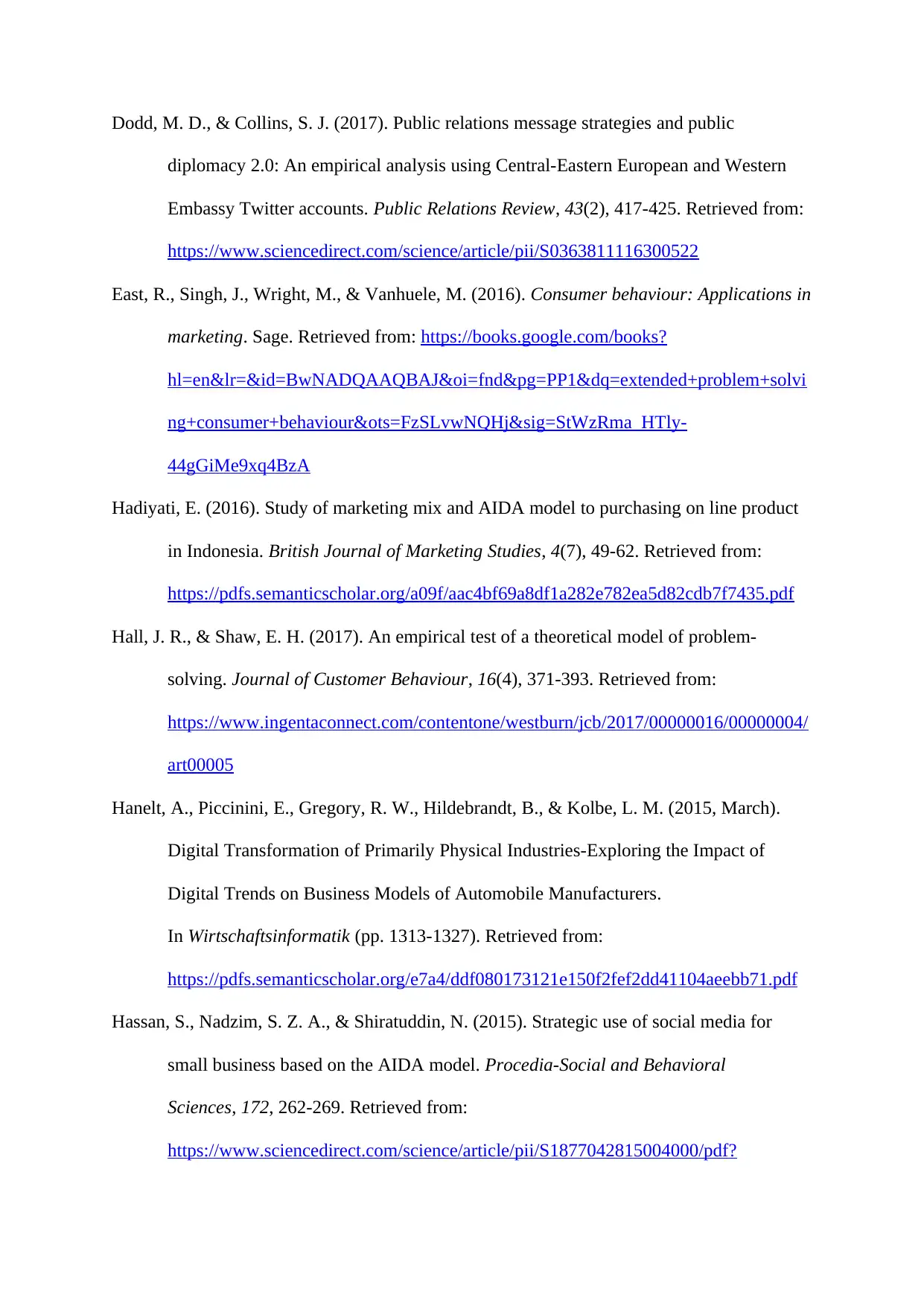
Dodd, M. D., & Collins, S. J. (2017). Public relations message strategies and public
diplomacy 2.0: An empirical analysis using Central-Eastern European and Western
Embassy Twitter accounts. Public Relations Review, 43(2), 417-425. Retrieved from:
https://www.sciencedirect.com/science/article/pii/S0363811116300522
East, R., Singh, J., Wright, M., & Vanhuele, M. (2016). Consumer behaviour: Applications in
marketing. Sage. Retrieved from: https://books.google.com/books?
hl=en&lr=&id=BwNADQAAQBAJ&oi=fnd&pg=PP1&dq=extended+problem+solvi
ng+consumer+behaviour&ots=FzSLvwNQHj&sig=StWzRma_HTly-
44gGiMe9xq4BzA
Hadiyati, E. (2016). Study of marketing mix and AIDA model to purchasing on line product
in Indonesia. British Journal of Marketing Studies, 4(7), 49-62. Retrieved from:
https://pdfs.semanticscholar.org/a09f/aac4bf69a8df1a282e782ea5d82cdb7f7435.pdf
Hall, J. R., & Shaw, E. H. (2017). An empirical test of a theoretical model of problem-
solving. Journal of Customer Behaviour, 16(4), 371-393. Retrieved from:
https://www.ingentaconnect.com/contentone/westburn/jcb/2017/00000016/00000004/
art00005
Hanelt, A., Piccinini, E., Gregory, R. W., Hildebrandt, B., & Kolbe, L. M. (2015, March).
Digital Transformation of Primarily Physical Industries-Exploring the Impact of
Digital Trends on Business Models of Automobile Manufacturers.
In Wirtschaftsinformatik (pp. 1313-1327). Retrieved from:
https://pdfs.semanticscholar.org/e7a4/ddf080173121e150f2fef2dd41104aeebb71.pdf
Hassan, S., Nadzim, S. Z. A., & Shiratuddin, N. (2015). Strategic use of social media for
small business based on the AIDA model. Procedia-Social and Behavioral
Sciences, 172, 262-269. Retrieved from:
https://www.sciencedirect.com/science/article/pii/S1877042815004000/pdf?
diplomacy 2.0: An empirical analysis using Central-Eastern European and Western
Embassy Twitter accounts. Public Relations Review, 43(2), 417-425. Retrieved from:
https://www.sciencedirect.com/science/article/pii/S0363811116300522
East, R., Singh, J., Wright, M., & Vanhuele, M. (2016). Consumer behaviour: Applications in
marketing. Sage. Retrieved from: https://books.google.com/books?
hl=en&lr=&id=BwNADQAAQBAJ&oi=fnd&pg=PP1&dq=extended+problem+solvi
ng+consumer+behaviour&ots=FzSLvwNQHj&sig=StWzRma_HTly-
44gGiMe9xq4BzA
Hadiyati, E. (2016). Study of marketing mix and AIDA model to purchasing on line product
in Indonesia. British Journal of Marketing Studies, 4(7), 49-62. Retrieved from:
https://pdfs.semanticscholar.org/a09f/aac4bf69a8df1a282e782ea5d82cdb7f7435.pdf
Hall, J. R., & Shaw, E. H. (2017). An empirical test of a theoretical model of problem-
solving. Journal of Customer Behaviour, 16(4), 371-393. Retrieved from:
https://www.ingentaconnect.com/contentone/westburn/jcb/2017/00000016/00000004/
art00005
Hanelt, A., Piccinini, E., Gregory, R. W., Hildebrandt, B., & Kolbe, L. M. (2015, March).
Digital Transformation of Primarily Physical Industries-Exploring the Impact of
Digital Trends on Business Models of Automobile Manufacturers.
In Wirtschaftsinformatik (pp. 1313-1327). Retrieved from:
https://pdfs.semanticscholar.org/e7a4/ddf080173121e150f2fef2dd41104aeebb71.pdf
Hassan, S., Nadzim, S. Z. A., & Shiratuddin, N. (2015). Strategic use of social media for
small business based on the AIDA model. Procedia-Social and Behavioral
Sciences, 172, 262-269. Retrieved from:
https://www.sciencedirect.com/science/article/pii/S1877042815004000/pdf?
Secure Best Marks with AI Grader
Need help grading? Try our AI Grader for instant feedback on your assignments.
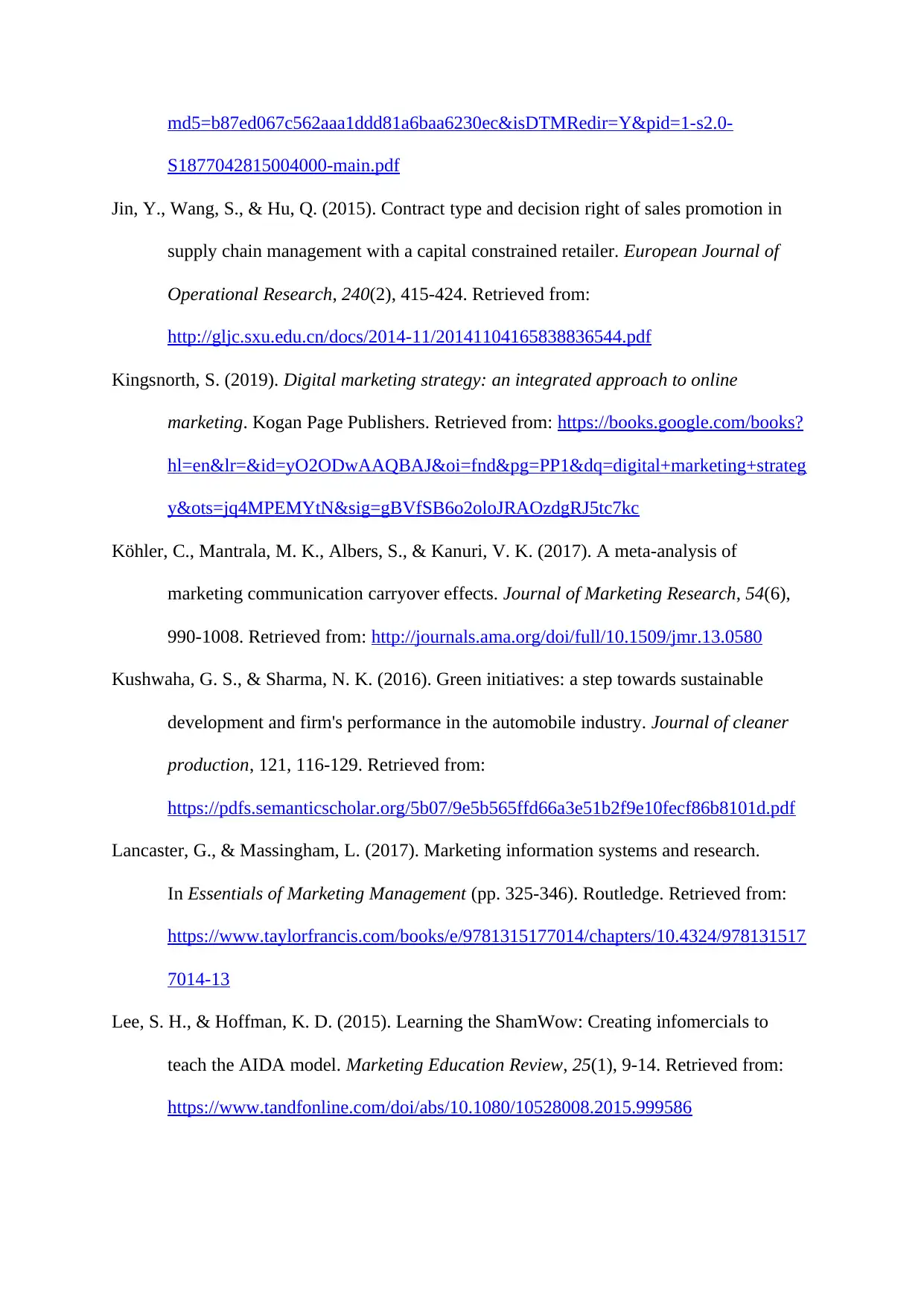
md5=b87ed067c562aaa1ddd81a6baa6230ec&isDTMRedir=Y&pid=1-s2.0-
S1877042815004000-main.pdf
Jin, Y., Wang, S., & Hu, Q. (2015). Contract type and decision right of sales promotion in
supply chain management with a capital constrained retailer. European Journal of
Operational Research, 240(2), 415-424. Retrieved from:
http://gljc.sxu.edu.cn/docs/2014-11/20141104165838836544.pdf
Kingsnorth, S. (2019). Digital marketing strategy: an integrated approach to online
marketing. Kogan Page Publishers. Retrieved from: https://books.google.com/books?
hl=en&lr=&id=yO2ODwAAQBAJ&oi=fnd&pg=PP1&dq=digital+marketing+strateg
y&ots=jq4MPEMYtN&sig=gBVfSB6o2oloJRAOzdgRJ5tc7kc
Köhler, C., Mantrala, M. K., Albers, S., & Kanuri, V. K. (2017). A meta-analysis of
marketing communication carryover effects. Journal of Marketing Research, 54(6),
990-1008. Retrieved from: http://journals.ama.org/doi/full/10.1509/jmr.13.0580
Kushwaha, G. S., & Sharma, N. K. (2016). Green initiatives: a step towards sustainable
development and firm's performance in the automobile industry. Journal of cleaner
production, 121, 116-129. Retrieved from:
https://pdfs.semanticscholar.org/5b07/9e5b565ffd66a3e51b2f9e10fecf86b8101d.pdf
Lancaster, G., & Massingham, L. (2017). Marketing information systems and research.
In Essentials of Marketing Management (pp. 325-346). Routledge. Retrieved from:
https://www.taylorfrancis.com/books/e/9781315177014/chapters/10.4324/978131517
7014-13
Lee, S. H., & Hoffman, K. D. (2015). Learning the ShamWow: Creating infomercials to
teach the AIDA model. Marketing Education Review, 25(1), 9-14. Retrieved from:
https://www.tandfonline.com/doi/abs/10.1080/10528008.2015.999586
S1877042815004000-main.pdf
Jin, Y., Wang, S., & Hu, Q. (2015). Contract type and decision right of sales promotion in
supply chain management with a capital constrained retailer. European Journal of
Operational Research, 240(2), 415-424. Retrieved from:
http://gljc.sxu.edu.cn/docs/2014-11/20141104165838836544.pdf
Kingsnorth, S. (2019). Digital marketing strategy: an integrated approach to online
marketing. Kogan Page Publishers. Retrieved from: https://books.google.com/books?
hl=en&lr=&id=yO2ODwAAQBAJ&oi=fnd&pg=PP1&dq=digital+marketing+strateg
y&ots=jq4MPEMYtN&sig=gBVfSB6o2oloJRAOzdgRJ5tc7kc
Köhler, C., Mantrala, M. K., Albers, S., & Kanuri, V. K. (2017). A meta-analysis of
marketing communication carryover effects. Journal of Marketing Research, 54(6),
990-1008. Retrieved from: http://journals.ama.org/doi/full/10.1509/jmr.13.0580
Kushwaha, G. S., & Sharma, N. K. (2016). Green initiatives: a step towards sustainable
development and firm's performance in the automobile industry. Journal of cleaner
production, 121, 116-129. Retrieved from:
https://pdfs.semanticscholar.org/5b07/9e5b565ffd66a3e51b2f9e10fecf86b8101d.pdf
Lancaster, G., & Massingham, L. (2017). Marketing information systems and research.
In Essentials of Marketing Management (pp. 325-346). Routledge. Retrieved from:
https://www.taylorfrancis.com/books/e/9781315177014/chapters/10.4324/978131517
7014-13
Lee, S. H., & Hoffman, K. D. (2015). Learning the ShamWow: Creating infomercials to
teach the AIDA model. Marketing Education Review, 25(1), 9-14. Retrieved from:
https://www.tandfonline.com/doi/abs/10.1080/10528008.2015.999586
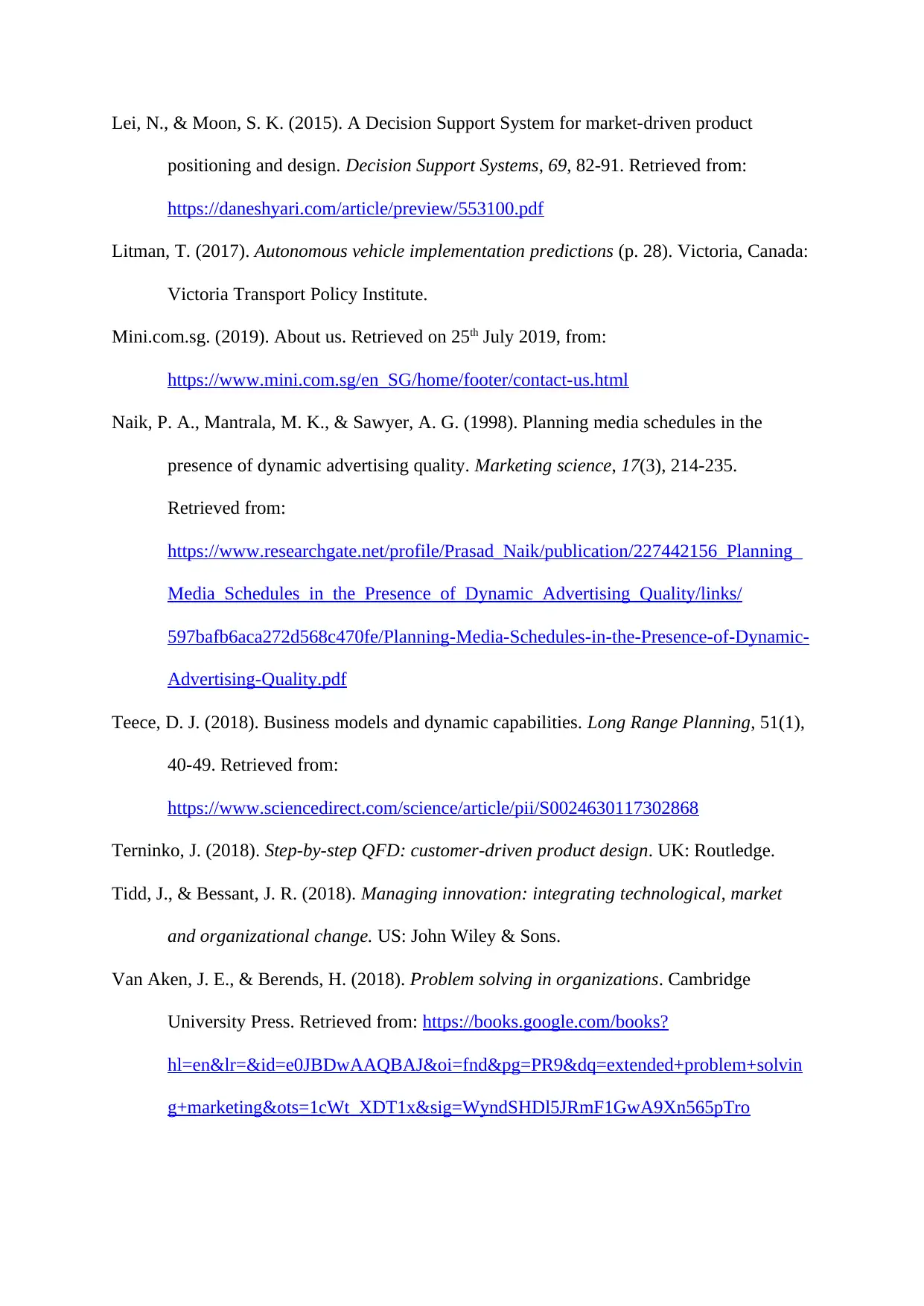
Lei, N., & Moon, S. K. (2015). A Decision Support System for market-driven product
positioning and design. Decision Support Systems, 69, 82-91. Retrieved from:
https://daneshyari.com/article/preview/553100.pdf
Litman, T. (2017). Autonomous vehicle implementation predictions (p. 28). Victoria, Canada:
Victoria Transport Policy Institute.
Mini.com.sg. (2019). About us. Retrieved on 25th July 2019, from:
https://www.mini.com.sg/en_SG/home/footer/contact-us.html
Naik, P. A., Mantrala, M. K., & Sawyer, A. G. (1998). Planning media schedules in the
presence of dynamic advertising quality. Marketing science, 17(3), 214-235.
Retrieved from:
https://www.researchgate.net/profile/Prasad_Naik/publication/227442156_Planning_
Media_Schedules_in_the_Presence_of_Dynamic_Advertising_Quality/links/
597bafb6aca272d568c470fe/Planning-Media-Schedules-in-the-Presence-of-Dynamic-
Advertising-Quality.pdf
Teece, D. J. (2018). Business models and dynamic capabilities. Long Range Planning, 51(1),
40-49. Retrieved from:
https://www.sciencedirect.com/science/article/pii/S0024630117302868
Terninko, J. (2018). Step-by-step QFD: customer-driven product design. UK: Routledge.
Tidd, J., & Bessant, J. R. (2018). Managing innovation: integrating technological, market
and organizational change. US: John Wiley & Sons.
Van Aken, J. E., & Berends, H. (2018). Problem solving in organizations. Cambridge
University Press. Retrieved from: https://books.google.com/books?
hl=en&lr=&id=e0JBDwAAQBAJ&oi=fnd&pg=PR9&dq=extended+problem+solvin
g+marketing&ots=1cWt_XDT1x&sig=WyndSHDl5JRmF1GwA9Xn565pTro
positioning and design. Decision Support Systems, 69, 82-91. Retrieved from:
https://daneshyari.com/article/preview/553100.pdf
Litman, T. (2017). Autonomous vehicle implementation predictions (p. 28). Victoria, Canada:
Victoria Transport Policy Institute.
Mini.com.sg. (2019). About us. Retrieved on 25th July 2019, from:
https://www.mini.com.sg/en_SG/home/footer/contact-us.html
Naik, P. A., Mantrala, M. K., & Sawyer, A. G. (1998). Planning media schedules in the
presence of dynamic advertising quality. Marketing science, 17(3), 214-235.
Retrieved from:
https://www.researchgate.net/profile/Prasad_Naik/publication/227442156_Planning_
Media_Schedules_in_the_Presence_of_Dynamic_Advertising_Quality/links/
597bafb6aca272d568c470fe/Planning-Media-Schedules-in-the-Presence-of-Dynamic-
Advertising-Quality.pdf
Teece, D. J. (2018). Business models and dynamic capabilities. Long Range Planning, 51(1),
40-49. Retrieved from:
https://www.sciencedirect.com/science/article/pii/S0024630117302868
Terninko, J. (2018). Step-by-step QFD: customer-driven product design. UK: Routledge.
Tidd, J., & Bessant, J. R. (2018). Managing innovation: integrating technological, market
and organizational change. US: John Wiley & Sons.
Van Aken, J. E., & Berends, H. (2018). Problem solving in organizations. Cambridge
University Press. Retrieved from: https://books.google.com/books?
hl=en&lr=&id=e0JBDwAAQBAJ&oi=fnd&pg=PR9&dq=extended+problem+solvin
g+marketing&ots=1cWt_XDT1x&sig=WyndSHDl5JRmF1GwA9Xn565pTro

Wang, N., Pan, H., & Zheng, W. (2017). Assessment of the incentives on electric vehicle
promotion in China. Transportation Research Part A: Policy and Practice, 101, 177-
189. Retrieved from:
https://www.sciencedirect.com/science/article/pii/S0965856416309193
promotion in China. Transportation Research Part A: Policy and Practice, 101, 177-
189. Retrieved from:
https://www.sciencedirect.com/science/article/pii/S0965856416309193
1 out of 25
Related Documents
Your All-in-One AI-Powered Toolkit for Academic Success.
+13062052269
info@desklib.com
Available 24*7 on WhatsApp / Email
![[object Object]](/_next/static/media/star-bottom.7253800d.svg)
Unlock your academic potential
© 2024 | Zucol Services PVT LTD | All rights reserved.





